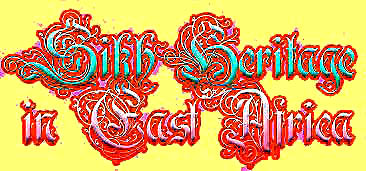
The following is a letter written by an Indian Station Master to his boss. The language used by the Station Master shows his utmost loyalty to his employers plus his contemporary Indian ability to use flowery language.
LONDIANI.
April 4, 1905
To
The Traffic Manager,
Uganda Railway,
Nairobi.
Most Honoured and Respected Sir,
I have the honour to humbly and urgently require
your Honour's to relieve me of my onerous duties at Londiani so as to enable me
to visit the land of my nativity, to wit, India forsooth.
This in order that
I may take unto wife a damsel of many charms who has long been cherished in the
heart-beats of my soul. She is of superfluous beauty and enamoured of the thought
of becoming my wife. Said beauteous damsel has long been goal of my manly breast,
and now am fearful of other miscreant deposing me from her loftly affections Delay
in consummation may be ruination most damnable to romance of both damsel and your
humble servant.
Therefore, I pray your Honour allow me to hasten India and
contract marriage forthwith with said beauteous damsel. This being done happily,
I will return to Londiani to resume my fruitful official duties and perform also
my natural matrimonial functions. It is dead loneliness here without this charmer
to solace my empty heart.
If your Honour will so far rejoice my soul to this
extent, and also as goes equally without saying that of said wife-to-be, I shall
for ever pray, as in duty bound, for your Honour's life- long prosperity, everlasting
happiness, the promotion of most startling rapidity, and withal the fatherhood
of many Godlike and lusty children to gambol playfully about your Honour's paternal
knees to heart's contentment.
If, however, for reason's of State or other
extreme urgency, the Presence cannot suitably comply with terms of this humble
petition, then I pray your most excellent Superiority to grant me this benign
favour for Jesus Christ's sake, a gentleman whom your Honour very much resembles.
I have the honour to be, Sir,
Your Honour's most humble and dutiful servant,
but terribly lovesick mortal withal,
(sd.) GOKAL CHAND
(B.A. (failed by
God's misfortune) Bombay University and now Station Master, Londiani)"
Not only did I approve of this quaint effusion, but wished Gokal Chand the
best of luck with his romance and application for leave to Bombay. I knew"
Cruicky" would be hugely entertained and would add this letter to his collection.
Later, I heard that Gokal Chand's leave had been granted; and, when next I saw
him, a purdah woman shyly peeped out at me from the depths of his quarters. I
wondered if she was as beautiful as her husband claimed! I shall never know. (Foran
[Cuckoo] p. 183/4)

GURDWARAS IN EAST AFRICA
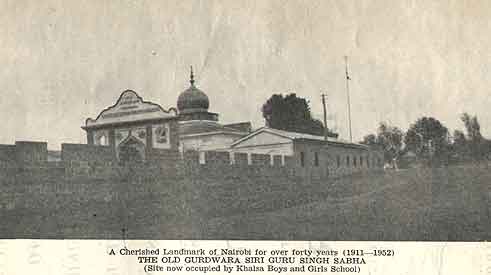

Laying of the foundation stone of Sri Guru Singh Sabha, Nairobi. The foundation stone of the New Gurdwara (below) was laid by S. Mohan Singh, S. S.S.Mehta, S.Kartar Singh [on behalf of his father S. Atma Ram Singh] , S. Jaswant Singh Bilkhu and S. Labh Singh Sagoo.
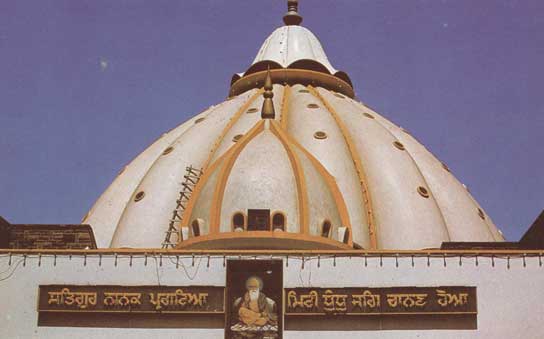
Gurdwara Singh Sabha Nairobi (Foundation of which being laid - above- read brief history below)
SIRI GURU GURDWARA SINGH SABHA NAIROBI - KENYA
A Short History
The main aim of the Singh Sabha was to restore the purity of the Sikh religion, to do away with non-sikh practices and inculcate love for Sikhism. It also encouraged publications of books and periodicals on Sikh history and religion and promoted the Punjabi language as a medium of teaching. In addition they also tried to influence prominent Englishmen and sought their support for educational programmes and other matters. It must also be remembered that the British had much respect for the Sikhs, for their character, bravery on the battlefield and the religious traditions they followed. So much so, that they encouraged Sikhs to join the army and expected them to wear their five symbols. Anyone trimming his beard was thrown out of the army.
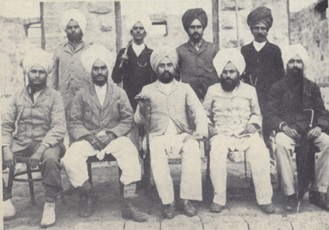 Sikh pioneers against the Gurdwara under construction - 1910
Sikh pioneers against the Gurdwara under construction - 1910
The foundation stone of the Gurdwara was laid by Sardar Kishen Singh in the year 1909. The building took more than a year to complete and the opening ceremony was performed by Baba Bishen Singh in 1911. There were only about one hundred Sikhs in Nairobi in those days, but what a magnificent Gurdwara did they build! The main hall was 36ft. long by 32ft broad with a ten feet wide verandah all round it. About ten rooms were also built to cater for the traveller's and the granthi (priest). The interior of the Gurdwara was artistically decorated. There was a massive entrance gate surmounted by a lion sculptured in stone. The glory of the Gurdwara was a huge bronze central dome which for many years was a landmark and showpiece in Nairobi. The opening was a day of rejoicing and the Sikhs travelled from Mombasa, Nakuru, Kisumu and other towns for this historic occasion.
In September 1956, a deputation approached the Government for grant of a piece of Crown Land at Byramjee Street, later named Uyoma Street. The application succeeded and plans were started around this time.
When the first plans of the new Gurdwara were discussed, the historical Golden Temple at Amritsar was very much in mind of the management. The element of the tradition was strong and compromise solution was found by the Architect Mr. Vamos. The present Dome was designed to reduce echo. The advice of the sructural Engineers Messrs. Gilbert A. Dean & Partners for structural safety was accepted.
The foundation stone for the Gurdwara was laid in an impressive ceremony on 16th January, 1959 by Sardar Mohan Singh, Sardar Santokh Singh Mehta, Sardar Kartar Singh on behalf of his father Sardar Atmaram Singh, Sardar Jaswant Singh and Sardar Labh Singh (see above photo). The construction took five years and this was not always plain sailing for the people concerned with construction. Unfortunately Mr. Gilbert Dean died in May, 1959. Capitol Construction Company started the works in 1960 and Messrs. Bansal Brothers Limited completed the works. Sardar Santa Singh, the Road Contractor tarmacked the open space inside the Gurdwara. The building was completed in 1963 and officially opened by Sardar Inder Singh Gill on 1 st November, 1963. The flag of the "Panth" was hoisted by Sardar Jodh Singh, retired Chief Inspector of Police.
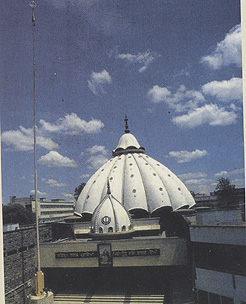
Siri Guru Singh Sabha Gurdwara(above) has right through held its weekly diwans on Sundays, Istri Sabha, the ladies wing in Racecourse Road on Fridays and the Istri Sabha, South 'C' on Thursday's. The Istri Sabha's always have been stout pillars of the Sabha. They have always assisted in the organisation of Guru ka Langar.
Since 1982 further improvements have been carried out on the Temple buildings and facilities enhanced. The tiling of the domes was done under the supervision of Sardar Tarlochan Singh Sagoo. The terrazzo paving of the court yard was laid by Sardar Phuman Singh Sahota. Apart from improving the aesthetic look of the complex, the domes have been rendered water proof and the flooring comfortable. The installation of extractor fans in the kitchen and extensions to the utility area adjoining it have greatly effected the working conditions in the kitchen complex. The construction and erection of the Nishan Sahib (Flag staff) by late Sardar Perminder Singh Sagoo, Chairman of Siri Guru Singh Sabha, has greatly given uplift to the image of the temple. Messrs Khushal Singh Laundry Limited has always provided the services of cleaning sheets and carpets. Various other people have rendered free and voluntary services to the community.
Text & Photographs courtesy of S/ri Gurdwara Singh Sabha, Nairobi, Kenya
GURDWARA BAZAAR-NAIROBI
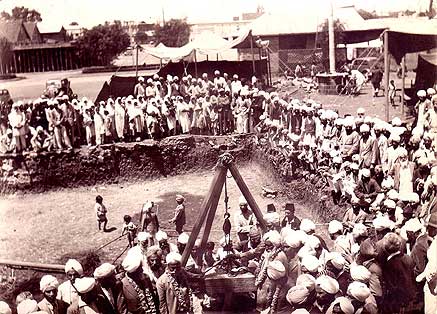
Foundation Stone being laid by S. Gujjar Singh Ghataore of the Gurdwara Bazaar, Nairobi in 1940. (Photo courtesy Amarjit Chandan - photo taken by his father S. Gopal Singh Chandan of Star Studio)
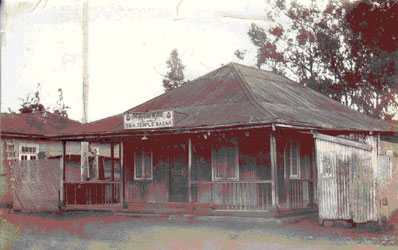
Gurdwara Bazaar Nairobi during the Forties - See the present building down (photo courtesy Amarjit Chandan)
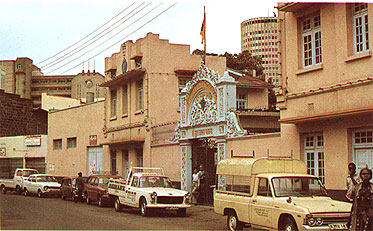
Gurdwara Bazaar, Nairobi
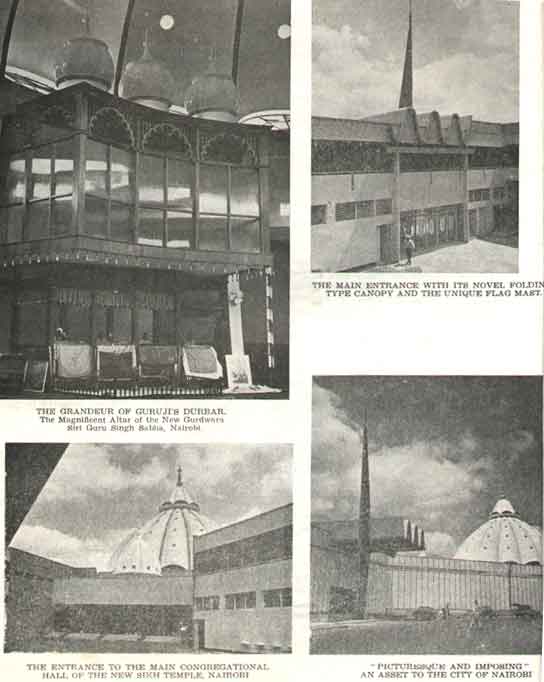
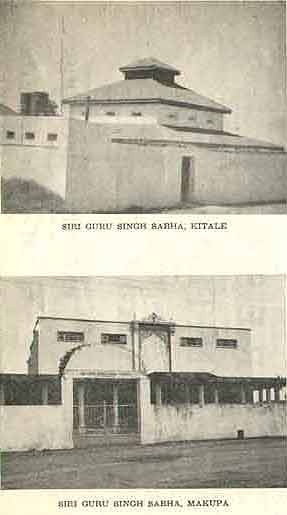
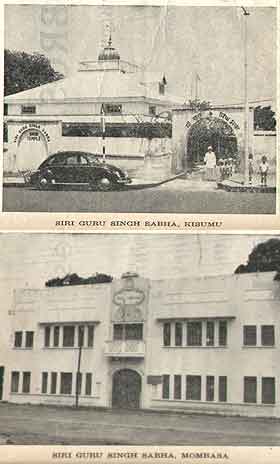
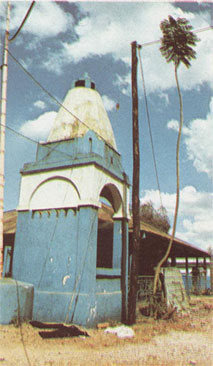
Gurdwara Balmik - Nairobi
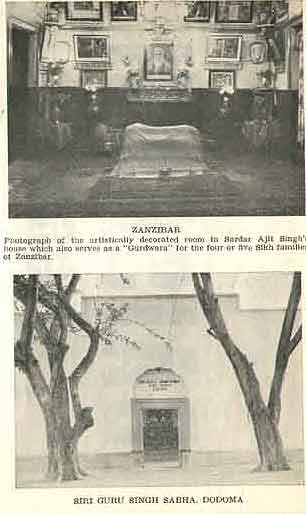
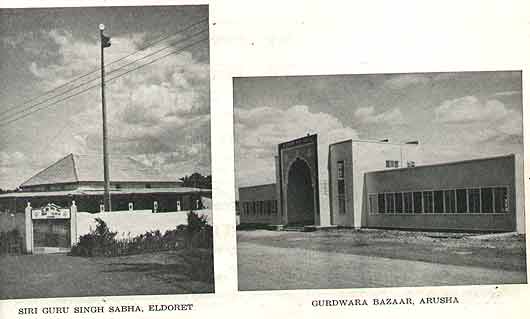
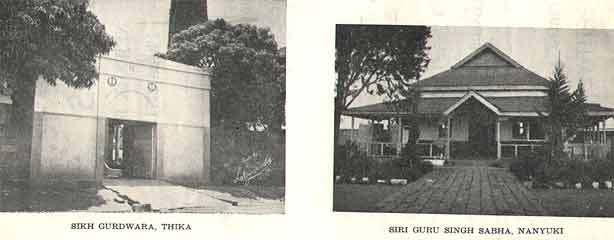
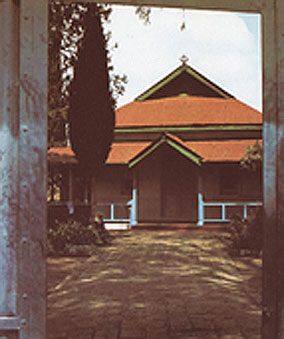
Gurdwara Nanyuki
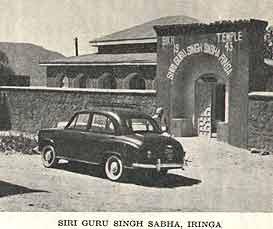
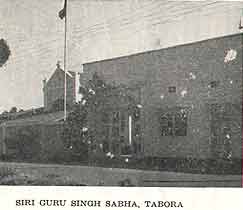
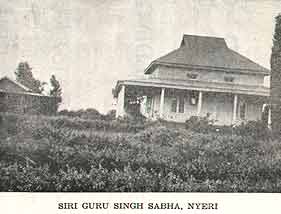
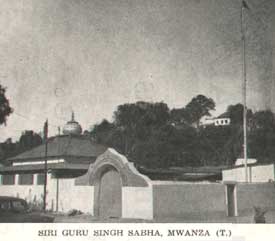
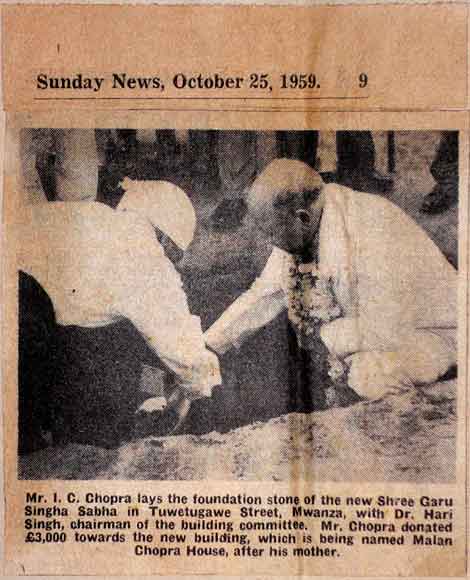
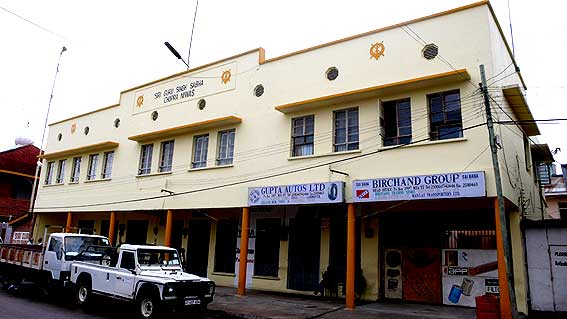
Mr. Chopra
originally came to Tanganyika from pre-Partition Lahore and Gujranwala.
He was a patron of the Gurdwara in Mwanza in the name of his mother,
Malan Puri, originally from Batala.
(informatiuon courtesy
Jarat Chopra)
SEE & READ PDF FILE FOR HISTORY & PHOTOS OF CHOPRA FAMILY DURING THE VISIT OF PRINCESS MARGARET IN 1956 ..CLICK HERE TO READ Article courtesy OLD AFRICA mag. (Thanks- Harjinder)
For more history of the Chopras please click to read pdf sent courtesy Jarat Chopra
Ramgarhia Gurdwara Kitale 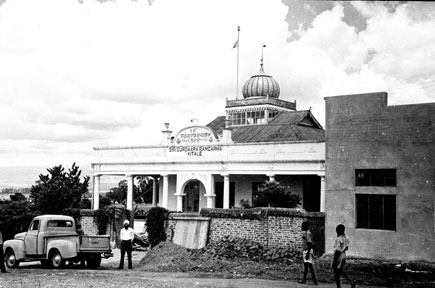
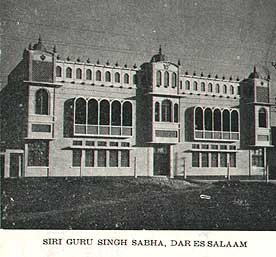
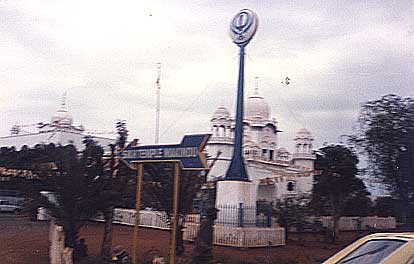
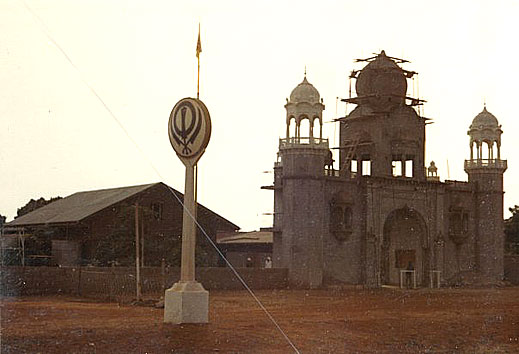
During the construction of Sikh Temple makindu - 1972
I can't resist giving my own witness. I always stop at the Makindu Gurudwara. Typically, when the generator blew up, someone brought a new one overnight and installed it. No one knew who did it. Such is the power of the Sikh concept of KARSEVA -- the pure act: nishkaama bhava, without a calculus of a karmic reward.
Sikh Temple Makindu was built in 1926, though its roots are believed to have been present way before then. When the Uganda Railway was completed in 1902 at Port Florence (which is now Kisumu, Kenya), Makindu played a prominent role as a service point on the railway's advance from Mombasa. Dozens of artisans and train drivers were Sikhs and the station at Makindu became a place of religious fervour. Sikhs, Hindus and Muslims would gather together in the evenings and sing the praises of God. They did so under a tree, the spot where the current Gurudwara now stands. It is also believed that the Gurudwara was funded by non-Sikhs along with Sikhs.
In the years before 1926, the Gurudwara was a tin-roof little hut where the Sikhs used to pray everyday, and the Guru Granth Sahib was housed there.
But when the Railway moved on from Makindu, the service point went into disuse and became unimportant.
The Sikhs naturally moved along too, leaving the tiny Gurudwara behind, under the watchful eye of an African servant who would clean the Gurudwara.
The Sikh devotees who passed along the Gurudwara would leave offerings of money by dropping it through the locked Gurudwara's window.
As the years rolled on and the Railway complete, the Sikhs settled in Kenya. Slowly, they began to contemplate the idea of reviving the small Gurudwara in Makindu. Akhand Paths began to be organised on regular weekends, with families travelling 200 Kilometers or so, in rough murram red-soil earth.
There, they would gather and pray, prepare Langar and socialise. Over the years, the Gurudwara began to be developed. It is in 1926 that a solid foundation was laid.
The Gurudwara then became a fully-functional one - with a Langar hall, prayer hall and tiny rooms of accommodation for the gyanis and sevadaars of the
Gurudwara. It also began to provide free food and rest for weary travellers who would stop by at the Gurudwara for a night or two on their journeys to and from Nairobi and Mombasa.
Legend has been connected to this magnificent Gurudwara. It has truly been referred to as the 'Harmandir Sahib' of Africa. It is so amazing that even now, as I pen these lines, an electric current runs through me, just thinking about the power of that Gurudwara.
A copy of the Guru Granth Sahib that survived a mysterious fire which burnt down the whole Gurudwara (probably before 1926) is still there today. I was fortunate to obtain the darshan of the Guru Granth Sahib at a Sikh's residence in Mombasa. On its first page, the then-Granthi of the Gurudwara recorded, in his own handwriting, exactly what had happened that day, and how miraculously, the Guru Granth Sahib was untouched by the tragedy to the Gurudwara.
An African sevadaar of the Gurudwara once claimed that he saw, in the night awoken from his sleep, a figure on a white horse. The horseman approached him
and spoke to him, telling him not to speak to anyone about the incident of his visit. The startled and shaken man could not believe his eyes and was so
scared that he told the first person he saw the following morning.
Asked who the man on the horse was, the African man pointed to a painting of Guru Gobind Singh whish was displayed in the Gurudwara and said, "'That was him!"
Exactly like that is there and so was the white horse!' The incident spread through the Sikh community like wild fire and soon people began to come more often to the Gurudwara, regardless of the miles that separated them from it.
The incident also prompted the Sant Baba Puran Singh Kerichowale (founder, Guru Nanak Nishkam Sewak Jatha) to lead Gursikhs to gather at the Gurudwara regularly, and serve it by prayer, Langar and cleaning.
The Gurudwara had been almost forgotten and neglected untill Guru Gobind Singh's incident occurred. That was not the only incident of the darshan of Guru Gobind Singh at Makindu Sahib.
People claim to have heard, in the silent of night, to have heard the approach of horses, just outside the Gurudwara. The sounds were akin to an army, stopping for the night. They claimed that they heard sounds of a kitchen being put in place, like langar was being prepared. Evidently, the incident was believed to be another darshan of the Guru, stopping by the shrine.
In yet another event, an amazing first-time encounter happened with a member of the Istri Sabha during the early years of the Gurudwara. A lady who was reading the Guru Granth Sahib in the night, lit by only a kerosene lamp (there was no electricity there then), witnessed in the shadow falling on the Guru Granth Sahib. The figure, she recalled, was of someone doing the 'chaur' over the Sikh Scriptures. The figure was, by description, none other than Guru Gobind Singh.
The Gurudwara today is among one of the most unique and beautiful ones outside India. Sikhs and non-Sikhs alike describe the same feeling when they
step into the Gurudwara - that of peace. It is an indescribable peace and bliss.
An aging European stranger I met at an art exhibition just the other day began talking to me about the Gurudwara when she saw me wearing a branded jacket of the Gurudwara. 'Oh, I've been there,' she told me, 'a beautiful temple, I must say.' She explained how a decade ago, she had stopped there for the night on her journey from Mombasa back to Nairobi, and said she had never felt so peaceful in her life before. She even felt the presence of someone seated in the passenger seat as she prepared to drive on the following morning. 'I'm not sure who that was, but I am certain there was someone there,' she explained. 'I didn't get scared, though, I took it as a good omen, like someone was keeping a protective watch over me as I embarked on my journey.'
Like this lady, there are thousands of people who stop by the Gurudwara on their journeys along the busy Mombasa Highway.
The Gurudwara attracts people of all races and colour - Hindus, Muslims and Christians. They all drive in like it is home. They always find a meal waiting for them and accommodation to take rest in. They feel no discrimination, or even the slightest hesitation that they are walking through a Sikh temple. It's a power there, I believe, that brings them here - a power that sees no differences. All feel the same bliss, as though they are not visiting a Sikh Temple, but walking through God's very own garden. As for the Sikhs, it is a favoured Gurudwara.
Politics have not touched this Gurudwara. Here, even the Managing Committees have been known to be part of the Sangat and sevadaars. Every weekend, there is someone or the other, making their journey to pay their homage to the Gurudwara, or simply to be at one with the Guru.
Whole families ravel there, unlike witnessed in Nairobi. Sikhs from not only all over Kenya, but from as far as Uganda and Tanzania who make regular trips to this eautiful Gurudwara, built on the common African soil. It is to be believed by the individual, and there are plenty of testimonies, that whatever one asks for at this Gurudwara, it is granted. Wishes have come true, prayers have been answered, if you come with a clean heart, cloaked in humility. Akhand Paths are regularly done there, and requests come from as far away fro Europe and Australia where ex-Kenya Sikhs are now settled, and yet remember the beloved Gurudwara they had to leave behind. Had it
been in their grasp, they surely would have taken it with them!
The setting of this Gurudwara is indeed a wonder. It is set in the wilderness, deep in the wild. Settlement has only recently sprung up around the Gurudwara. It is about 200 kilometres from Nairobi and yet you will find Sikhs gathering at the Gurudwara almost every weekend. Here they spend the whole day, resting, praying and simply witnessing the still air in its extremely well-kept gardens. Right across the road is the new Sikh Hospital - Mata Veera Kaur Hospital - which is a community establishment, serving the locals who have no immediate professional health care for hundreds of miles around. On my most recent visit there in 2001, I could see the Gurudwara through the thorn bushes at the Railway Station. The sight was one to behold. There, right before you was a white structure, in the midst of all the browns and greens of the wilderness, standing tall, yet humble. The Gurudwara stands like the lotus flower that grows in the mud. The only was to describe the sight
when I saw it was Bliss in the Bush'. A note to make here is that there not a single
Sikh family resident in Makindu and yet the Gurudwara continues to flourish, through the goodwill (article and photo courtesy Dharam Parkash - Thanks to Raghbir Rahi )
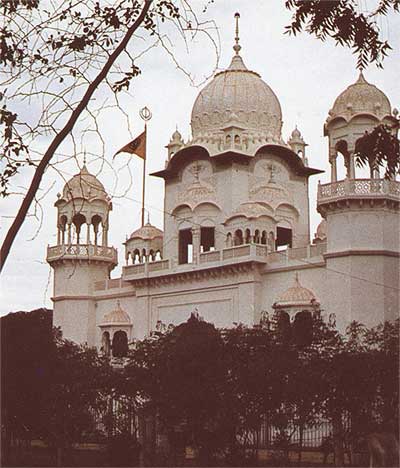
Sikh Temple MAKINDU, on the main road from Nairobi to Mombasa
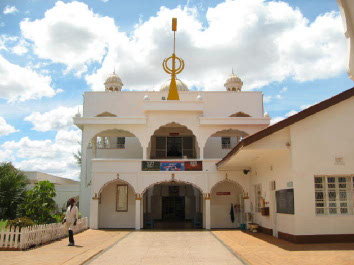
Sikh Temple Makindu
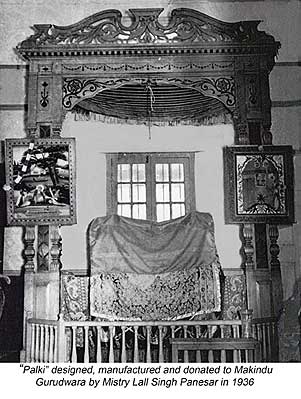
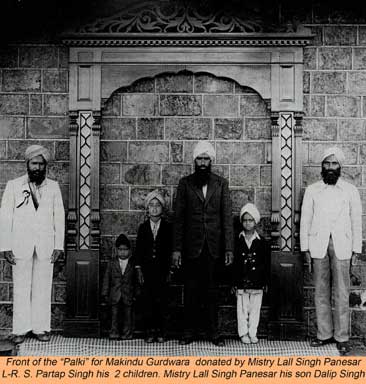
Above photos sent by Dhanwant Mundae (thanks)
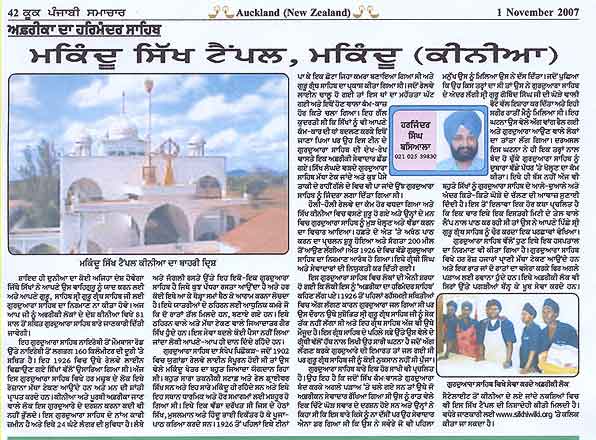
PROFILE OF WARYAM SINGH DHESI (KHALIFA) One of the pioneer founders of Makindu Gurdwara. (sent by Gurrbaksh Singh Dhesi (Bakshi) Bakersfield, California)
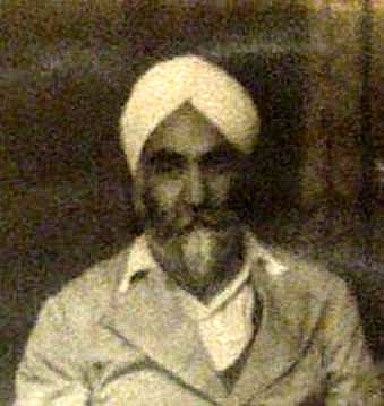
My father Waryam Singh was born in 1886 in the village of Sang Dhesian in the Punjab. He was youngest of seven children: two girls and five boys. His father passed away when he was nine years old. His sisters were married off. One brother became a Sant (holy man) and became a wanderer. One brother, the father of Buta Singh. passed away. Two brothers died in the Plague of 1892 at Lyalpur and his ancestral farming land at Sang Dhesian was wrested from him by the village Zaildar. He was raised by our grandmother in utter poverty, most of the times he was physically abused and made to work for food. As a child he was befriended by one Karam Singh Dhesi, nicknamed Madhoo, who became his mentor. Time went by and he grew up to be a tall strong young man and decided to find his fortune overseas. At that time people from the Punjab were migrating to other parts of the British Empire and the Americas. The main port and the labour recruiters for the colonies were based at Bombay. In 1902 our father left his village in the Punjab and made his way to Bombay. He was sixteen years old. Being a tall Sikh young man he managed to get a job as a security guard at a Bank on Marine Drive in Bombay. At the same time East African Railways were recruiting artisans and labourers to work on the construction of the Railways in Kenya. Some five or six Ramgharia Sikhs named Kalsi from his village of Sang Dhesian had been recruited as artisans by the East African Railways, and had made their way to Bombay for embarkation to Kenya. As he was on guard duty one day, he recognised the Kalsis, who were out for a walk on Marine Drive. He approached them and they suggested to him that the best way for him was to pretend to be a Kalsi and join them on the trip to Kenya, which he did. In 1903 my father with the Kalsis travelled from Bombay to Mombasa in what I believe was a dhow, which took about forty five days. He was seventeen years old. On their journey there were some Ramgharia Sikhs, a few Jatt Sikhs and the rest of the group was made of Harijans. The Ramgharias and Jatts had segregated themselves from the Harijans with separate kitchens. It was quite a long journey during which the Ramgharia and Jatt food ran out. They had to join the Harijans in sharing their food, and the caste barriers of the group were shattered. From Mombasa my father ended up in Nairobi where he was employed in the Railway workshops as a rivet banger on the railway cars. After some time he graduated to be a steel fitter in the local shed. As the farming was still in his blood, while at Nairobi, he acquired a small farm outskirts of the town on River Road and also set up a gym to teach fellow Sikhs wrestling, as he had become an expert wrestler. Apart from Kenyan wrestlers, many wrestlers visiting Kenya came to wrestle there. However, none of them could defeat our father in wrestling, so the people gave him the title of Khalifa. Years passed in continuous employment. Eventually our father travelled back to India in 1925. He made his way to Sang Dhesian, where he built a house for himself in the village behind Kehar Singh Kalsi’s house. In due course he got married to our mother Gurbachan Kaur. New religious ideologies in the 20th century had caused tensions in the Sikh religion. The Akali Dal (Army of the Immortals), a political-religious movement founded in 1920, preached a return to the roots of the Sikh religion. The Akali Dal became the political party which would articulate Sikh claims and lead the independence movement.
One of the major campaigns in the Sikhs' agitation was for the reformation of their holy places. The campaign, which elicited enthusiastic support especially from the rural masses, took the form of a peaceful agitation-marches, divans or religious gathering (Jathas) and demonstrations for Sikhs to assert their right to manage their places of worship. This led to a series of mass arrests and imprisonments by the authorities. The people who fed these Jathas on their marches were also arrested and imprisoned. As one of the hungry Jathas was passing through his village, my father entertained them to a Langar, that is, he fed the hungry marchers, for which he was arrested by the authorities. He was given the option to apologise, which he declined, and was sentenced and imprisoned for six months in Rawalpindi Jail with one of his nephews Karam Singh. In Rawalpindi Jail, my father was given a bag of grain to grind for the group. My father refused to grind the whole bag which was given to him, but for a couple of handfuls of grain, which he thought was sufficient for his needs. Consequently he had a confrontation with the Jailer (a Muslim lifer who had been made a trustee) and during the altercation, my father picked him up and threw him down, whereas he cracked his head and died. My father was locked up in solitary confinement and the authorities were arranging to hang him. Most of the Sikh protesters in various prisons, there were thousands of them, hearing of his imminent hanging, went on hunger strike. To stave off a mass rebellion and finding that my father had migrated to Kenya, the authorities allowed him to sort out his affairs, which included the marriage to our mother Gurbachan Kaur. She was born at Magsulpur, Hoshiarpur Dist. Punjab. Then the authorities deported him to Kenya. In 1926 he journeyed back to Kenya with our mother and grandmother. He resumed his employment with the Kenya Railways for some time. Eventually he resigned from the Railways and moved to Makindu, where he became a fuel supplying contractor to the Railways. Makindu at that time was a dreary isolated village. The only place of note was the Railway Shed. Our parents lived in a mud hut on the outskirts of the village. Our mother tells us that a pride of lions use to come roaming around the huts at night time. Mr Chuni Lal and his brother ran small general stores at Makindu, while Babu Tara Singh Ahluwalia was the station master. The Lal brothers, Babu Tara Singh and our father got together and collected some money from Nairobi Singh Sabha Gurdwara and built the Makindu Gurdwara, practically a tin roofed hut. Our father also planted some fruit cuttings which he had brought from the Punjab at the Gurdwara, and I believe that the fruit trees are thriving to this day. On April 27, 1930, the new Gurdwara was opened at Makindu in the presence of about 150 Sikhs from East Africa. The new Gurdwara is described as "a magnificent stone building with fine arches at the front and back and a beautiful garden."
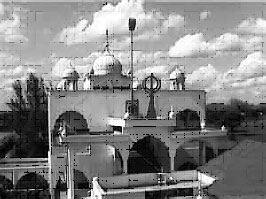
‘Sikh Temple Makindu is located about 100 miles (160km) from Nairobi on the main Nairobi to Mombasa Road. It was built in 1926 by the Sikhs who were working on the construction of the railway line from the coast (Mombasa) inland to Lake Victoria and beyond to Uganda. Today, all types of people visit this Gurdwara everyday and it is a 'must-see' Gurdwara for any Sikh travelling to Kenya and East Africa. It provides a peaceful atmosphere where one can meditate and calm ones mind before proceeding to join the "rat-race" again. The Gurdwara complex is very large and has facilities for langar around the clock and living accommodation for travellers. Set in the forest off the main road, the Makindu Gurdwara is the only convenient rest stop for weary motorists on this busy and long road to and from Mombasa. So the Sikh community of Kenya has done something special by building such a beautiful edifice and campus where anyone of any religion or of no religion can withdraw from the mundane and reflect on the spiritual. This large complex houses a huge dining facility which provides free langar 24 hours a day as determined by their founder Guru, Guru Nanak Dev. Rooms with beds - several with attached bathrooms - are available for tourists to stay for up to two nights. Everyone in Kenya seems to know of it and most tourists stay to rest and eat. Most are non-Sikhs. There is no charge for this service, but most people donate to the Gurdwara. Apparently it is run by a consortium of the Nairobi Gurdwaras. The aura at Makindu would calm the most tormented mind; one automatically drifts away from the mundane and towards the spiritual and peaceful.’(Extract taken from the website Sikhi Wiki, in the article Makindu Sikh Temple)
In 1930 our father had a whole stack of wood ready to be picked up by the Railways that caught fire and got burnt. He could not sustain the losses and had to fold up his business. At the birth of my elder brother Jaswant in 1931, he moved to Kakamega with his nephew Buta Singh. On the eve of his deportation from India, he had adopted Buta Singh as his own son, and had brought him with him to Kenya. On the move to Kakamega , my father and Buta Singh were employed by the Rosterman Goldmines as mechanical technicians. In due course I was born in Kakamega in 1934. In 1937 our father moved to Eldoret, where he worked for East African Power and Lighting Company. As the instincts and passion of farming had never left him, he also acquired a small farm in Eldoret. My younger brothers Kulwant, Narindar and Surindar were born in Eldoret.
As my older brother Jass was afflicted with Muscular Dystrophy my father thought that the climate in Mombasa might help and he got transferred to Mombasa in 1942, which of course did not help. In 1945, with the shortage of technicians in Uganda, he was transferred to Jinja to work for Uganda Electricity Board. My elder brother Jass passed away in 1949 in Jinja. The rest of us had an ideal upbringing and schooling in Jinja. As his passion was for farming, he also acquired a small farm by Lake Victoria at Jinja. In 1956 while our father was working for Uganda Electricity Board at Owen falls hydraulic dam at Jinja, the Queen Mother performed the opening ceremony of the dam and the Power Station. During the ceremony our father Waryam Singh Dhesi and one of his Sikh colleagues Harjodh Singh were presented to the Queen Mother.
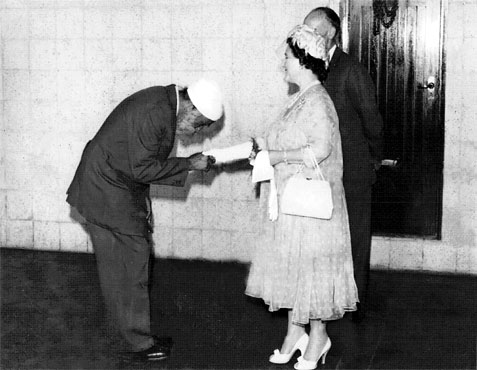
Our father being presented to the Queen mother at Jinja in Uganda.1956
They were the only two Asians presented to her. Our father retired in 1963 and went back to his village in the Punjab, where he built a large house for his retirement. Our brother Kulwant passed away at Sang Dhesian in the same year. Our father felt nostalgic for Africa and came back to Uganda in 1966 and stayed with me for a year. Meanwhile I started working for Uganda Electricity Board, and became a regional trouble shooter and was responsible for taking electricity to the unlighted regions. When Uganda gained Independence from Great Britain in 1962, I renounced my British Nationality and became a Ugandan citizen. During my employment in the high echelon of the Uganda Electricity Board I became quite close to the President Milton Obote. I had to flee Uganda in 1971 when Idi Amin seized power and was eliminating the people who had been close to Milton Obote. However, through the offices of Mr Kironde I returned to Uganda and back to my employment with the Uganda Electricity Board. On 4Th August 1972, the then President of Uganda, Idi Amin, ordered the expulsion of his country's Indian minority, giving them 90 days to leave Uganda. Amin said that he had had a dream in which God told him to order the expulsion. The Uganda authorities revoked my citizenship and consequently I became a stateless person. Canada was gracious enough to offer me refuge. Surindar and Narindar had migrated to England. After few years I sponsored Surindar, who joined me in Canada. Our father had an ideal retirement and died peacefully at Sang Dhesian in 1978. Narindar and I went to Sang Dhesian to do the funeral rites and brought our mother back with us. She went to Calgary in Canada with me and eventually stayed with Surindar, while I migrated again, this time to the United States. Our mother passed away in Calgary in 2008. She is survived by her children and grandchildren and great grandchildren in England, Canada and United States.
===================================================================
THE SIKH LANDMARK IN KENYA – MAKINDU
(By Avtar Singh Matharu – Email: avtar.matharu@sky.com) [sent by Rohina Grewal]
At some KPA meetings, when reminiscing with my colleagues about Kenya, the above landmark of the Sikhs is often inquisitively mentioned. It is a Sikh Temple which has historical links with the arrival of The British East Africa Company, and construction of the Uganda Railway. I thought I should relate the background of this Temple as, it seems, little is known about it in some quarters.
1. The construction of the 582 miles of the Uganda Railway was commenced on 5 August 1896 by the British East Africa Company. The skilled and unskilled labour in those days could not be better sourced from anywhere other than from British India, by which time the Indian Railways system in many parts of the country was well established by The British East India Company. It reached Kisumu (initially named Port Florence) on Lake Victoria on 19th December 1901. Florence was the wife of the engineer Preston. She had the honour of hammering in the last fish plate of the railway track
2. Amongst the work force were many Indians of the Punjab Province. They were the ideal community to be able to face the harsh climate and wild conditions of East Africa. The Punjabis were composed of the Sikhs, Muslims and Hindus. It has been customary for the Sikhs, when undertaking major events e.g. going to war, they would carry with them their religious Holy Book, the Guru Granth Sahib (see below)and prayed, by holding congregation, as they advanced.
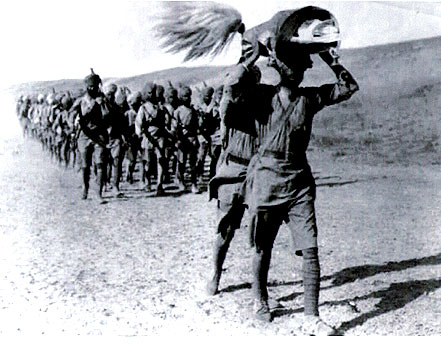
Therefore, their undertaking in building the Uganda Railway was not going to be an exception. The BEAC officials recognised this strength of the Sikh work force. So they happily facilitated this religious practice recognising that it could only be good for morale of the Sikhs.
3. When the railhead reached Makindu, a Uganda Railway Depot was established there. A loco shed and other ancillary services were set up, and the small town began to grow. The Indian ‘duka-wallahas’ were quick enough also to set up their shops. The town had a sizeable Sikh community working for the Uganda Railways. A request by the Railway Sikhs for building a temple was accepted by the Railway officials, and a sizeable plot of land was granted. In keeping with the spirit of self-help of the Sikhs, it was not long before a simple structure of corrugated iron sheets was built in the form of a temple. In keeping with the tradition of Sikhism, the temple building had four doors on either side of the approximately 30 feet square hall. The significance of the four doors is to welcome all mankind, irrespective of race, caste, creed, colour etc from all four directions of the compass. The temple stood on a stone plinth with a veranda about eight feet wide which formed the perimeter. The other facilities of the temple consisted of a kitchen, living quarters and stores. It was surrounded by a fence of corrugated iron sheets with one gate at the rear, and stood on the main Nairobi/Mombasa road, then no more than a dust track. In due course, larger railway steam engines came into service which did not necessitate engine changeover at Makindu. Hence, Makindu lost its key position, and the railway depot town declined. The Sikh Temple also shut down.
4. I am able to give a vivid description of the Makindu Sikh temple, as I had been there twice in the early 1940s at the age of nine and ten. We then lived in Nairobi. My father also worked in the civil engineering department of the Kenya Uganda Railways and Harbours, as it was known then. Previously, of course, it was only Uganda Railways, when he joined it in 1920 from the Indian Railways at Amritsar in Punjab where he worked as an apprentice under the tutelage of his grandfather. The service later became East African Railways and Harbours in 1947/48, when Tanganyika Railways (built by the British competitors – the Germans) joined the East African Community. In 1944/45 in Makindu there also used to be a Greek POW camp, albeit moribund. Also nearby there were two grave tomb stones of the Europeans who had died at Makindu, presumably railwaymen. The reason of our childhood visits to Makindu was school holidays. In those humble days it was customary for one railways family to visit another at different destinations. We joke with our children, and grandchildren, that the kind of holidays they enjoy today, were unknown in our childhood!! In the course of such holidays, in the early forties, I visited Menengai (near Nakuru) and Samburu (next to McKinnon Road Station, which became Mau Mau detainee centre in the 1950s) from Kampala, and Fort Ternen Station from Kisumu!! Those much coveted train journeys were part of the holiday fun.
The Sikh Temple at Makindu continued to suffer neglect from its erstwhile regular function till late 1950s, although, the Nairobi Sikhs used to visit on a particular day of the month in the Sikh calendar for the essential rituals. The temple, when shut, was looked after by a Mkamba caretaker-cum-watchman. The original Holy Book from India, which the pioneer Uganda Railway workers had carried with them during the advancing construction, and installed at Makindu Sikh temple, was moved to the family home of a pioneer devout Sikh resident of Kericho. In his memory, the Kenya ‘Kalasingas’ and ex-Kenya ‘Kalasingas’ in the United Kingdom, have recently built a fine establishment, “Nishkam Saint Puran Singh Institute”, at Kericho. Late Mr Puran Singh, a notable pioneer personality amongst the Sikhs, had a motor workshop in Kericho. This particular copy of the Holy Granth Sahib was ceremoniously returned from Kericho to Makindu Sikh temple in 2010 (see under).
5. Having suffered a period of neglect, Makindu Gurudwara began to flourish once again and gained its prominence, starting from early 1960s, to become today’s religious edifice of the Sikh faith in Kenya. Legend has it that in late 1950s, the Mkamba caretaker/watchman saw many times a ‘Kalasinga’ coming to the temple on a blue horse, and that he also heard the noise of hoofs of a horse. This phenomenon was reported by the watchman to the Nairobi Sikhs who used to visit the temple once a month for perfunctory ceremony. The Sikhs interpreted the watchman’s experience as a wake up call for serious contemplation; because the “visitor on a blue horse” in their view could be none other than the 10th Guru of the Sikhs (Guru Gobind Singh), for this is the imagery of the Guru in the Sikh psyche. Guru Gobind Singh, .along with his father, the 9th Sikh Guru (Guru Tegh Bahadur), gave his life opposing and fighting the injustices of the Mogul rulers, and also defending and preserving Hinduism. Hence, it was decided to revive the Makindu Sikh Temple. So, the development work commenced in earnest, albeit in stages, as the entire project was donation and self-help dependent, mainly from the Sikh community in East Africa.
6. Today, on the Nairobi/Mombasa highway, stands a Sikh Temple with its white prominent domes, and flies a yellow triangular flag on a high mast with the Sikh religion symbol (see picture below) high up in the sky, which are visible from a very long distance whichever direction one drives from.
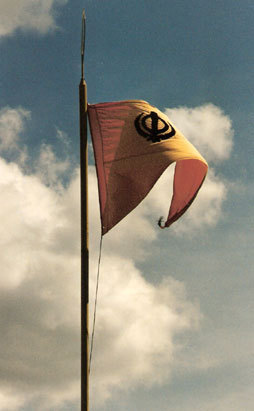
The temple complex consists for a two storey large building on the site where once stood the humble corrugated iron sheets structure. On the top floor is the Temple Sanctum. Adjacent to this magnificent building is the large dining hall and a large kitchen, which is an essential aspect of any Gurudwara, where free meals are served. Normally, the kitchen would be staffed by volunteers as a self-help aspect of Sikh principles, but as there are hardly any permanent resident Sikhs in Makindu, the temple employs a team of locals for this purpose. However, when the Sikhs visit the temple they invariably participate in this essential activity as well. The food is exclusively vegetarian and wholesome Punjabi diet. The dining facilities are open to all, irrespective of race, caste, creed, colour or status in keeping with the Sikhism edict: that mankind is one. No donation is asked for, and should one want to make, he is directed to the Temple Sanctum in order to pay their respect and insert the donation in the box, or the office where a receipt is issued. This would apply to a non-Sikh visitor who is not conversant with the Sikh custom. The Sikhs, however, as a rule, would first go to the Temple Sanctum. The kitchen normally functions 24/7, but due to security situation, on occasions this may vary after dinner time. The kitchen cleanliness standard is high.
7. The complex also has facilities for overnight stay for the visitors. This is in form of self contained apartments with on-suite bath and toilet, plus supply of hot and cold water. They are fully furnished. The bed linen is supplied. The accommodation caters for about one hundred visitors, if not more, as they have recently been converted into two storey units. A team of local women is employed for cleaning and servicing this facility, and the gardens. I would equate this accommodation to a three star facility. Many tourists, especially European back packers, often stay there. At lunch time generally the dining hall is busy as most travellers, driving either from Nairobi or Mombasa, arrive at Makindu at that time. At the time of Sikh festivals, however, the place it very busy as many Kenya Sikhs, and from abroad, converge there. I suggest any KPA members, when visiting Kenya and travelling to or from the coast, do stop here. You would be most welcome there.
8. Opposite the Temple complex is located a small hospital-cum-dispensary for the benefit of the locals. Mombasa road being what it is, it is often the first point of medical assistance for the road accident victims. The function of this medical unit is fully donation based, primarily by the Kenya Sikh community.
9. Legend also has it that one’s supplications at the Makindu Sikh Gurudwara are rewarded. It reminds me of a Church on the tourist route along St Laurence River in eastern Canada, which we stopped at whilst on holidays there in 2001. The priest read his prayer to the tourist party, in which my wife and I also participated. He said the same of this Church, and showed us walking sticks and crutches of those who brought them back after recovery!
10. The Kenya Sikhs, and ex-Kenya Sikhs in the UK with their major Gurudwara establishment in Birmingham, were anxious to return the original Guru Granth Sahib, which had been installed by the Sikh Uganda Railway pioneers at Makindu, from Kericho to Makindu. This was done in 2010 very ceremoniously. It was carried from Kericho to Kisumu by road.
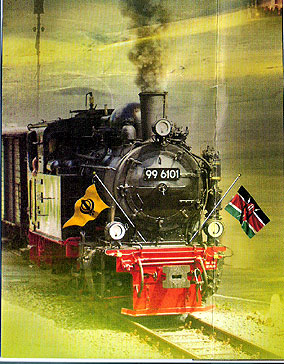
A special railway train (above), bearing the Kenya National and the Sikh emblem flags, was arranged for the onwards journey from Kisumu to Makindu. The Holy Train stopped at Nakuru, Nairobi and finally steamed to Makindu. The Sikh ceremonies were performed en-route at each stop, with free meal service to the populace who came to witness the event. This journey was undertaken from 31 January to 7 February. The original Guru Granth Sahib was installed in a new building at Makindu. It was a well publicised event in Kenya. The Sikhs of Kenya continue to live harmoniously, happily and participate in all aspects of the country’s economy and development.
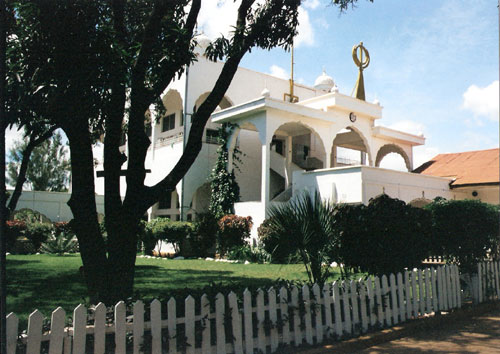
Sikh Temple Makindu
====================================
The tale of electrification of Makindu Temple, 1967. (sent by Parmjit Mangat)
"With a little help from our neighbours from Tanganyika"
In July 1967, a wedding party of Ismaili Khojas from Mwanza travelled by road to Mombasa to attend a marriage. Mr. Harjit Singh, s/o Sardar Prem Singh of Tanganyika Bus Services, Mwanza, and his wife, Mrs. Amrit Kaur were in that party.
On their way back to Mwanza, the party stopped at the Mackinnon Road mosque and subsequently Makindu Sikh temple. As it was night time, the contrast between a well lit mosque and a pitch dark temple was so stark that it inevitably, drew some less than favourable, comments from the Ismailies.
Stung by these well founded and well intended remarks, Mr Harjit Singh felt so humbled, that he immediately got in touch with his contacts to inform them of the dire need to provide electricity to the temple and took upon himself to fund the entire project.
Consequently, Mr. Kaushal, the then Chief Electrical Engineer, Nairobi city Council, assisted in the purchase of a generator from a Sikh gentleman, who owned an Electrical shop near the City Hall. However, when Mr. Singh became aware of the intended recipient of this generator, he refused point blank, to take any payment for such a noble cause, and it was only after considerable pressure that he accepted a highly discounted price, just to cover costs. Kaushal Brothers, Electrical contractors, Limuru, provided all the materials and four of their Sikh employees to carry out the work, all this free of charge. SEVA.
So one fine Saturday morning in September 1967, a convoy of 4 vehicles, laden with materials, men and a few Sikh ladies left for Makindu and by nightfall the lights were switched on. "Jungle mein Mungle"
The local farmer provided some vegetables and the ladies prepared the langar. The rooms were in a bad state so the ladies slept in the hall and the men in their cars.
In November 1967, on Puranmashi Gurpurb, the secretary of the Sikh Sabha Gurdwara, Nairobi, chided his fellow Nairobi Sikhs for letting their country cousins from Tanganyika, who did not even use that route, take this initiative. Once this word got around, donations poured in, extra rooms were built and Akhand Path was organised. All within two months. At the Bhog ceremony at the beginning of 1968, all the top raggis of Kenya were there to do justice to the occasion.
The rest, as they say, is history.
=================================================================
The desecration of the Sikh Temple Makindu (by Harjinder Kanwal)
My last visit to Makindu Sikh Temple in 2012 was a disappointing one. The old ‘Heritage’ building of the gurdwara was nowhere to be seen. New buildings were all over the place with two star hotel rooms in abundance.
I am not criticising the progress of this small gurdwara but my grievance is with the authorities who completely destroyed the old temple and its existence. This temple was built by our ancestors who sweated and toiled to build a small shrine in the middle of the jungle with little means of material and tools.
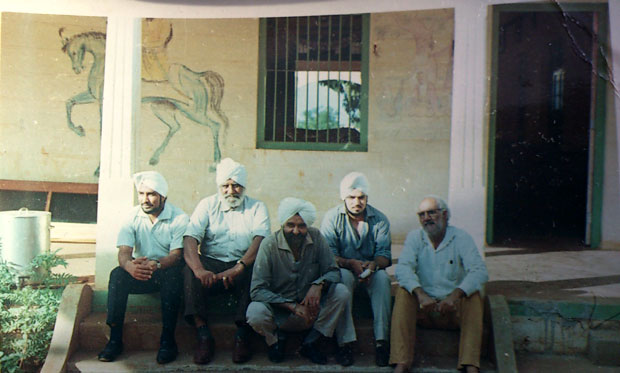
On the steps of the old sikh temple Makindu 1960. See the painting of Guru Gobind Singh Ji on the wall.The person on the Right was a resident of the village , my father ( Mohinder S Riyat) is seated 2nd from the right, he informs me at the time it was not easy to find the Temple as the entrance was via the village, When we visited later the developing of the site had commenced , and the adjacent farm was in the process of being established (sent by Ricky Riyat) . All this completely destroyed.
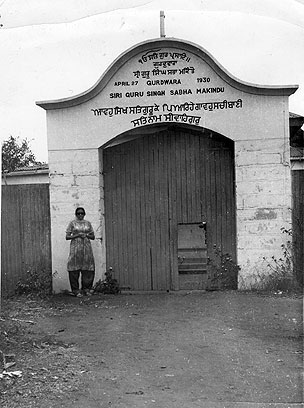
A very rare picture of the Main gate of the Gurdwara (sent by Sati Bassan)
Their selfless efforts were not to get any monetary gains but their love for their religion and love for their Guru.
If there was need to build another gurdwara, the old relics should have been preserved as ‘heritage’ buildings are preserved all over the world. A very good example is the ‘Gurdwara Railways Landhies’ where the originality has been maintained with exceptional care and preservation (see photo below).
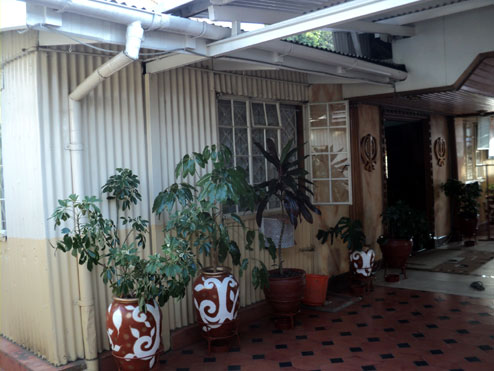
Gurdwara Railway Landhies preserved with original corrugated sheets still intact. Bravo.
I am sorry to say that Makindu gurdwara is nothing more than a 2 star hotel without any regard for the sentiments and homage to hundreds of the Sikhs who gave their lives to build the railway line and lost their lives to lions and killer diseases.
A great ‘Sikh Heritage’ lost forever by unscrupulous people.
===================================================================
SEE THE ROLE OF SIKH WOMEN IN KENYA Click on this pdf file (sent by Desraj Dahele)
------------------------------------------------------------------------------------------------
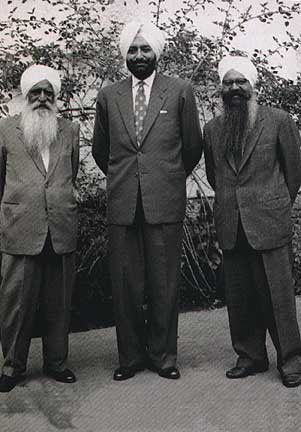
Maharaja Of Patiala Yadvendra Singh being flanked by S. Labh Singh and S. Kirpal Singh Sagoo, who was the first Sikh to receive the OBE in Colonial Kenya.
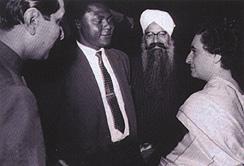
Kirpal Singh Sagoo meets the Indian Prime Minister Indira Gandhi. The Indian High Commissioner and the late MP Tom Mboya are also in the picture
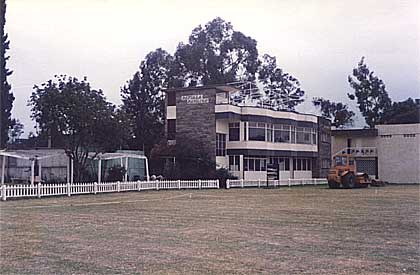
The Patiala Pavilion of the Nairobi Sikh Union Club was officially opened by the Maharaja of Patiala, Yadvendra Singh on his visit to Nairobi during the 60's. Below is a photo of him receiving a 'Saropa' from Sri P.S.Kanwal during his visit to the East African Ramgarhia Board. Secretary H.S.Sahota is on the mike.
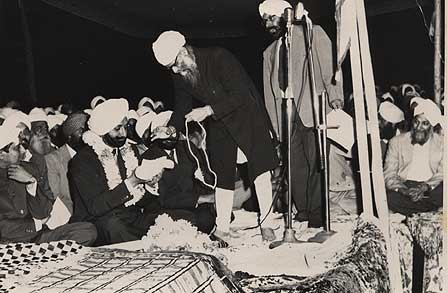
RAMGHARIAS
IN EAST AFRICA:
When the Europeans tried to make East Africa progress
and prosper, the Ramgarhias then in East Africa played a very important role as
far as the building of houses and railway lines was concerned.
As East Africa advanced economically, the Ramgarhias were rolling in money and became owners of colossal buildings and businesses. Their children had all the facilities for a sound education. Most of them went overseas and returned as doctors, lawyers, engineers and other professionals.
NAIROBI - KENYA:
The Ramgharias in Nairobi achieved prominence by assisting in the erecting of Gurdwara Singh Sabha, Gurdwara Bazaar, Gurdwara Landhian and other Sikh temples. Before long there emerged other small Sikh sects and each sect began to work for its own people. Sardar Hem Singb Ji Amritsari and Sardar Kehar Singh Ji Kalsi, the then leading contractors in Nairobi thought of forming an organisation of the Ramgharias and in 1934 the "Ramgharia Board" came into being.
The East African Ramgarhia Board,
Nairobi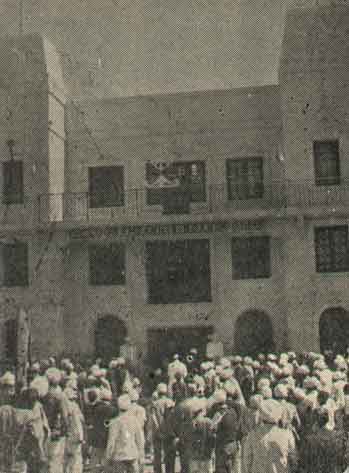
The Ramgharia Board soon began to function and some leading figures began to preach the aims and objects of Sikhism. Various religious ceremonies were regularly celebrated and with assistance of hard working and- religious minded volunteers the Board was able to complete 101 "Paths".
The keen interest
and the co-operation of the public enabled the Board to organise and successfully
carry out 17 conferences. Leading Ramgharias from Kenya, Uganda and Tanzania took
part in these conferences. The 18th conference was held in 1960 under the Presidentship
of Sardar Tara Singh Ji Dogra at Eldoret. In this conference some new rules and
regulations for the improvement of Sikh temples were passed and after the conference
great steps were taken to foster unity amongst the Sikhs.
In 1958 the Ramgharia
Board had its elections and Sardar Bakhshish Singh Sian was elected as the President.
Under his management the Board made quite a lot of progress and more people began
to show interest and soon the Board bought a 31/2-acre plot at the junction of
Fort Hall Road and Juja Road for five lakhs. Quite a substantial amount, which
had been collected by the previous management, helped the present committee to
pay for this plot.
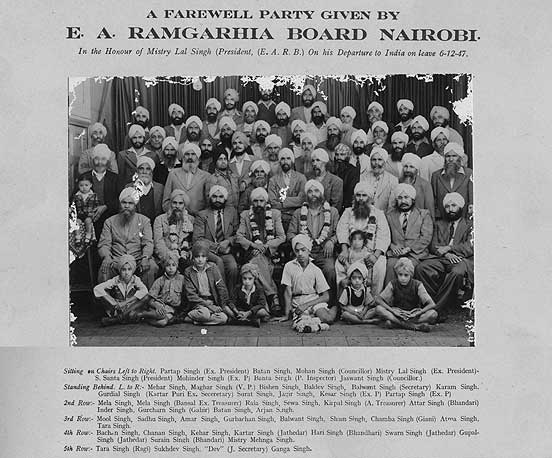
A very unique photo taken in 1947 (courtesy Meharban Singh Juttla)
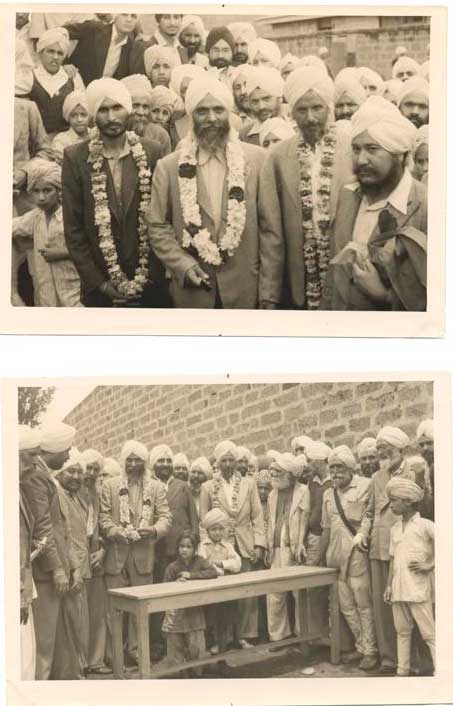
Some members of the Ramgarhia Board being honoured around 1950
RAMGHARIA SIKH
DISPENSARY
At the 18th conference in Eldoret it was unanimously
decided that a Sikh dispensary should be opened for the benefit of the poor population
regardless of caste and creed. Because of the high fees of private doctors, a
need for a dispensary was greatly felt and soon the first Ramgharia Sikh Dispensary
was opened on the 18th of November, 1959, by Sardar Jagat Singh Matharu (Director
Jagat Singh & Sons).
Soon it was felt that a similar dispensary be
opened and on the 2nd of September, 1962, another dispensary was opened in Eastleigh
Section 11, about two miles from Nairobi, by Sardar Hari Singh Ji (M/s. Hari Singh
& Co.) [Below]
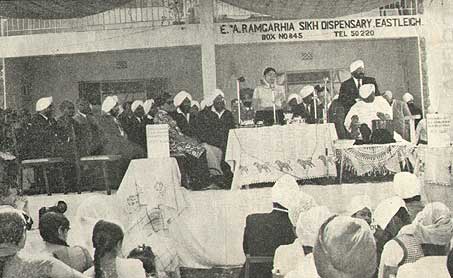
Facing the Ramgarhia Board was a three-storied building the ground floor of the
building had shops, while the first and second floors had residential flats where
quite a few families lived happily paying yearly rents. Two of the shops on the
ground floor were converted into a dispensary. About 500 patients visited the
two dispensaries monthly. The city Council also showed a keen interest in the
improvement of the dispensary after having known that the dispensary was for people
of all races.
LIBRARY
A library is a great source of knowledge.
It is place where via newspapers, books and magazines one is able to know about
what is going on all over the world. A community that does not have a library
restricts its development. The governments of almost all countries have opened
public libraries for the benefit of its citizens. Keeping this in mind the Ra-mgharia
Board decided to convert one of the shops in the three storied building into a
library. Soon the library was flooded with Hindi, Panjabi, Urdu and English books.
The opening of the Library was done on the 13th April, 1959 by Sardar Kartar Singh
Ji (Directorate: Bansal Brothers, Nairobi). The Africans made a very good use
of this library.
SOCIAL HALL
Facing the Ramgharia Gurdwara was an empty space. Many suggestions for making something on this plot were considered and it was finally decided that a beautiful social hall be built. With donations from various people in the form of cement, sands, wood, etc., a beautiful hall was built. A substantial donation towards the building of this was from Sardar Hardial Singh Ji, (Directorate Hardial Singh and Bros. Ltd.). Sardar Kartar Singh Ji Shankar Wallah laid the foundation stone of the building. The hall had a 3-feet high stage with a beautiful curtain. At the back was a gallery. The Hall, which was soundproof, had a capacity of 2,000. 'Gurpurb" functions, marriages and other social and religious occasions were celebrated in this Hall. The Hall was one of the few good Halls in Nairobi.
From the above achievements it was obvious that the Ramgharia Board had been very active and helpful. Apart from building dispensaries and libraries the Board had been and is giving scholarships to intelligent students who cannot pursue their studies due to lack of finance. The Board is proud of having helped to make quite a few doctors, engineers and lawyers, now playing a very important role in the development of this country. The Board has been assisting widows and orphans by providing them with accommodation and other necessary requirements.
SOME PROMINENT RAMGARHIA ELDERS
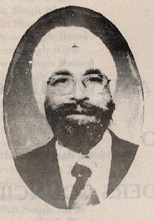
Councillor Bakshish Singh Sian, past President Ramgarhia Board, Nairobi
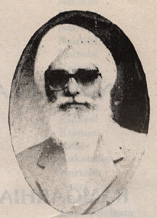
Mistry Santa Singh Road Contractor - member Ramgarhia Supreme Council
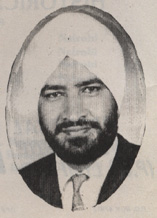
S.Tarlok Singh Nandhra, a renowned architect and past President Ramgaria Board
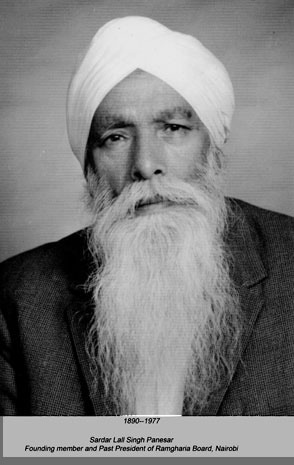
The following article has been taken out from a magazine printed in 1982.
MEMOIRS OF SARDAR HEM SINGH BHANGRA
BY SATINDERJIT SINGH MATHARU
The Ramgarhia Sikh Community is deprived of a respectable and pioneer personality, Sardar Hem Singh Bhangra who passed away on Friday 25th March, 1983 after short illness. His life Span of 58 years was full of pleasant smile, good sense of humour and bubbling laughter which will always be remembered by his family, relatives, friends and colleagues.
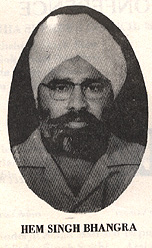
Sardar Hem Singh Bhangra was bom on 2nd April, 1925 at Raikot, Punjab, India. Where he received his education and passed matriculation. He arrived in Kenya sometimes in 1947 to join his father Mistry Santa Singh Bhangra, a respectable personality in Civil Service during the War time when he had assisted the Authorities to recruit thousands of Asian Manpower in all trades and later a successful businessman as a Saw Miller.
Sardar Hem Singh Bhangra proved to be an asset to his father in the business and gradually took over from his father with successful planning of expansion of business of Kapsabet Saw Mills now a well-established business under the name of Bhangra Saw Mills. He further marched ahead with prosperity with God's Grace as Building and Civil Engineering Contractors in the name of Construction Engineers and Builders Ltd. and Come-cons Africa Limited with the association of his able and hardworking Sons Sardar Parladh Singh Bhangra, Bahadur Singh Bhangra and his nephew Kuldip Singh Sira and are established as reputable Contractors.
During his best years in business as me// as an enthusiastic Social Worker, Mr. Bhangra earned reputable Credit and Scored popularity and established Cordial relations with various Communities of Asian Origin and Government Leaders which prompted him to contest Civic elections during 1954/1955 which he won with heavy majority and rendered his Services to the Council selflessly and tirelessly. He also Served on International Organisations like Lions Club and Masonic Lodge. AllSikh Societies had great faith and always looked forward to him for his valuable guidance and advice.
Sardar Hem Singh Bhangra who was a staunch Supporter ofE.A. Ramgarhia Board, a member of Ramgarhia Supreme Council, Ramgarhia Elders Council, and Patron of Ramgarhia Health Centre and Ramgarhia Trust Fund, had played a key role in keeping the Ramgarhia Community United as well as generous Donor for all Development Projects of the Community and other worthy Causes of National Welfare.
During his Life time he adopted a Noble policy to assist financially and in Welfare matters less fortunate families irrespective of their Caste, Colour or Creed and has left many a grateful behind him.
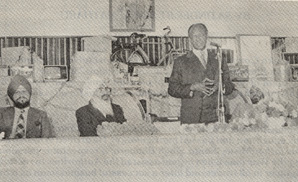
A Fund Raising Raffle in aid of Ramgarhia Health Centre was Organised, the Draw of which took place on 25th February, 1982 when Sardar Hem Singh Bhangra presided over the Function along with the Guest of Honour, the Minister for Constitutional Affairs, Honourable Charles Njonjo, M.P. and gave generous donation for this worthy Cause. (see above photo)
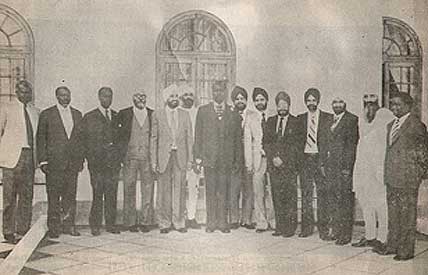
Ramgarhia Sikh Leaders with the President of Kenya, Daniel Arap Moi (1982)
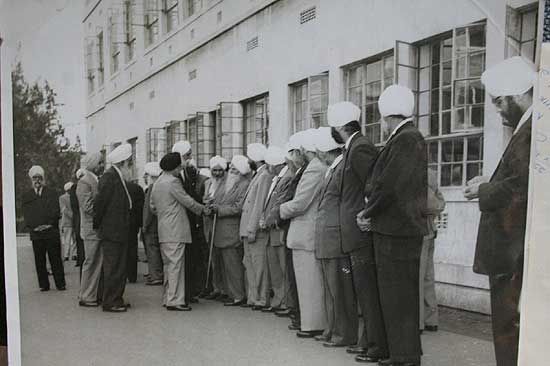
Indian Speaker of Parliament S. Hukam Singh being introduced to S.Narain Singh and other prominent members of the Sikh Community by S. Mohan Singh & S.Sardar Singh Vohra. Principal Gurbaksh can be seen on the extreme left. Photo taken at Khalsa Boys & Girls School, Nairobi. (photo courtesy G.Bhari)
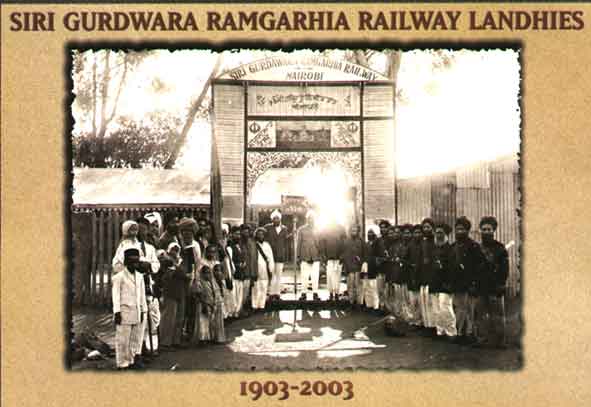 An
Historic photo of the opening of Gurdwara Ramgarhia Railway in 1903, and the photo
below of the committee who celebrated 100 years of the Gurdwara, (photos -courtesy
of S. Balbir Singh Kalsi, ex treasurer Ramgarhia Board Nairobi)
An
Historic photo of the opening of Gurdwara Ramgarhia Railway in 1903, and the photo
below of the committee who celebrated 100 years of the Gurdwara, (photos -courtesy
of S. Balbir Singh Kalsi, ex treasurer Ramgarhia Board Nairobi)
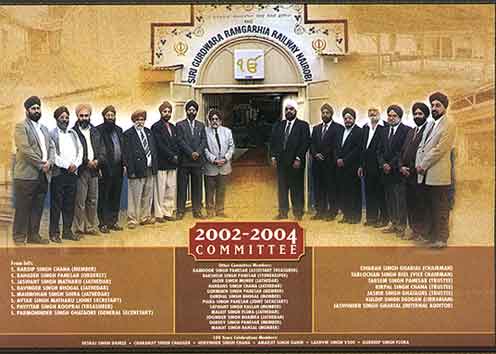
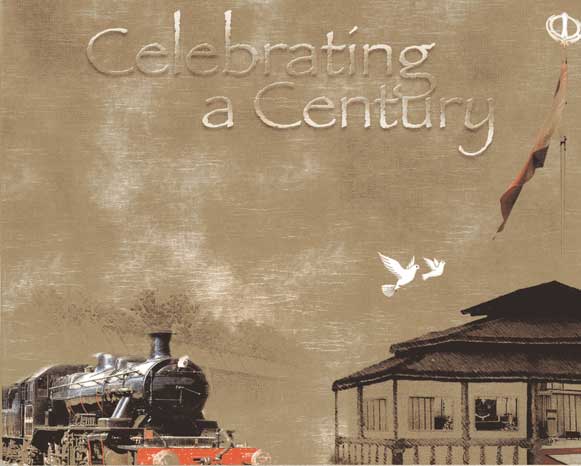
Landhies: Journey into time
(Presenting a very informative article-Courtesy) Amarjit Singh Gahir
The earliest arrival of Sikhs in East Africa can be traced back to 1896, who came with the thousands of coolies and entrepreneurs to seek employment Railway and also to set up businesses in this promising new colony. The Sikhs worked in the Railway as engine drivers, guards, coolies, artisans, station masters and also in the locomotive sheds
As the Sikh community grew in the country, so did their needs for a spiritual and social gathering place, The first Gurdwara in Kenya - in fact, in all Africa was opened in Kilindmi literally within weeks of the arrival of the first shipload of indentured labourers in 1898, The original iron and wood building was soon replaced by a more substantial edifice.
As the Railway advanced further inland from Kilindini, the Sikhs developed another Gurdwara near Mukupa as the
Community began growing in that region. A single-roomed tinned and wooden structure served as the Gurdwara in the Railway Quarters where the Sikhs resided in Makupa, These quarters came to be known as Landhies. The Gurdwara has now been converted into Guru Nanak Clinic managed and run by Siri Guru. Singh Sabha Gurdwara of Mombasa.
The Railway's progress saw the construction of maintenance sheds at 100km intervals, with one each in Voi, Makindu and Nairobi. The Railway line gave birth to yet another Gurdwara, this time in Makindu, where a considerable number of Sikhs served their duties in the locomotive
maintenance sheds,
In Nairobi, the first Gurdwara was made in the spot where the Machakos Country Bus Station is today. This Gurdwara was named simply Siri Gurdwara Landhies. As the Sikhs were housed in the Railway Quarters in the current location of Siri Gurdwara Ramgarhia Railway Landhies, the Gurdwara moved from the Country Bus Station location to the current site in 1903. This area was an extremely vibrant settlement where the growing Sikh community blossomed.
1920 witnessed the birth of another Landhies Gurdwara, this time in Kisumu. It's only remnants today are the original floor and a stone pillar that once held the Nishaan Sahib, The ever growing Sikh, community of Kisumu made it inevitable for the Landhies Gurdwara to be replaced by a bigger one, which is today's Ramgarhia Sabha Gurdwara Kisumu which
was built in 1949. The old site of the Landhies Gurdwara is now occupied by indigenous charcoal sellers.
Memories of the early days of Nairobi's Landhies temple still live amongst, some of the oldest residents in the community. They recall seeing the temple as a four-door temple made of tin sheet and wood, with a tin roof. There was no electricity then and Sighting was provided by hurricane lamps. The 'jamun’ tree, still there today, has seen through 100 years and ought to be seen as a testimony to the passage of time. It. has served generations as a place of solace, where one can find union with Waheguru, immersed in sewa, simran and sangat. It has also served, just like other Gurdwaras, as a social place, where events like weddings, lodging for travellers, serving the needy and a host for visiting ragis and holy men from India and beyond who have found home in the African soil.
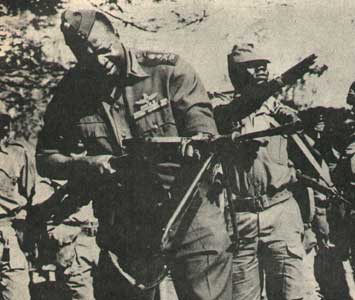
THE ATROCITIES OF DICTATOR AMIN IN UGANDA
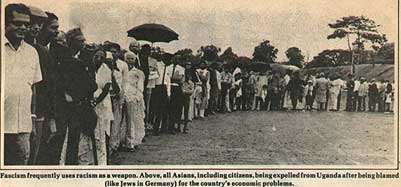
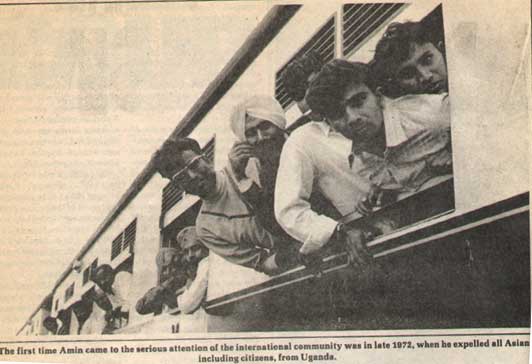
It was during the 1950's that the British Royal family members started visiting East Africa, and in this repect Princess Margaret, the Queen sister visited Nairobi. The people were very enthusiastic and gave this beautiful Princess a resounding welcome. All the Asian communities built gates on the nearly 2 mile long Government Road to bid welcome to the Princess. Here we show some of those gates built by the Muslims, Sikhs and Hindus. But the best gate was built by the Sikhs as can be seen. The artist Hari Singh Bansal was responsible for this masterpiece. He also built another gate for the Namdhari Singhs in 1959, which is also shown. He was also responsible for building the Gurdwara at Makindu and some Mosques and Mandirs in Nairobi and in other parts of East Africa.
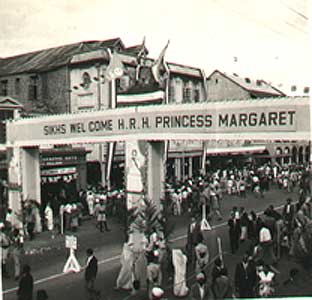
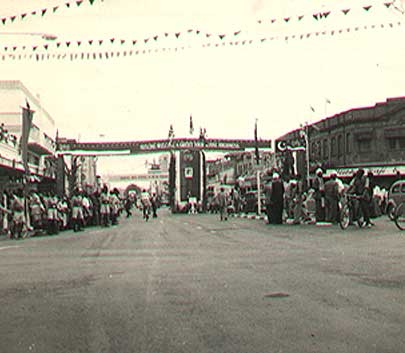
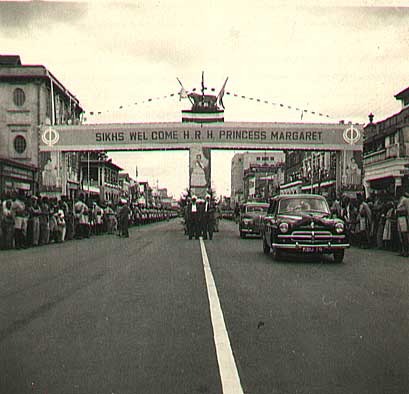
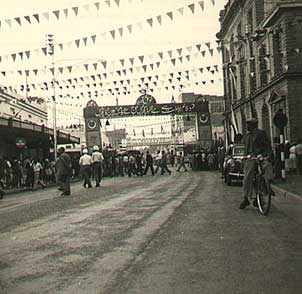
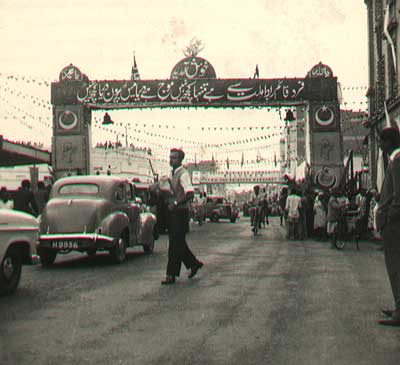
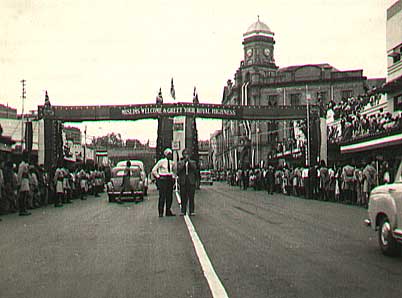
Sikhs pose in front of the Muslim gate with the Khoja Mosque in the background.
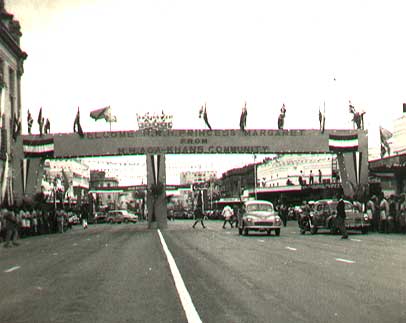
The Gate of the Ismailia Community - a very prosperous community with the blessing and leadership of His Highness the Aga Khan.
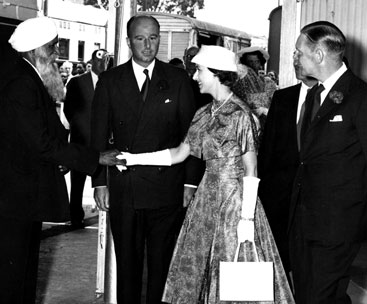
Mistry Lal Singh Panesar meeting HRH Princess Margaret (photo courtesy Dhanwant Mundae)
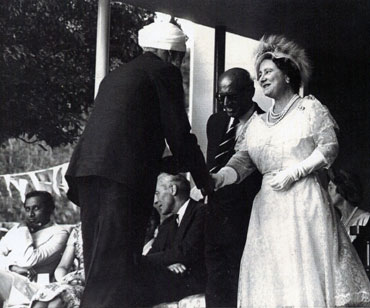
Mistry Lal Singh Panesar meeting the Queen Mother in Nairobi (Photo courtesy Dhanwant Mundae) (also below)
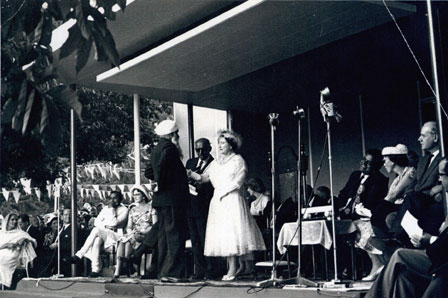

THE PINK DIAMOND
IC Chopra Presents Pink Diamond to H R H Princess Elizabeth . Read full story below:-
The above photograph was taken in 1948 by The Topical Press Agency Ltd.
The story by Jarat Chopra about the "PINK DIAMOND":-
Tanganyika Diamond Presented to Princess Elizabeth in 1947 The Royal Collection calls this Tanganyika gem the “finest pink diamond in existence.” The London Times reported: “A pink stone such as this and of this quality is a rare freak of nature.” virtually flawless, 54 ½ carats in the rough and of priceless value, the stone’s exceptional character is in its colour: a pale, warm and exceedingly rare hue of pink.
Its generous finder described it as “A beautiful rose-coloured‘collector’s piece’.” A cultural icon in its own right, it inspired the Pink Panther diamond in the film series of the same name, and more recently it was the object of pursuit in the movie Blood
Diamond. At the mine of its origin at Mwadui, then Tanganyika, the staff watering hole was dubbed “The Pink Diamond.” In 1947 the jewel was given “on behalf of the people of Tanganyika” as a wedding present to the young heir apparent, Princess Elizabeth. The gift was one in a long history of philanthropic acts in East Africa and internationally by the two partners in Williamson Diamonds Limited, Dr John Thorburn Williamson and The Hon Iqbal Chand Chopra, King’s Counsel and a member of Tanganyika’s Legislative (and later Executive) Council. Williamson, a Canadian geologist from McGill University had ventured to Africa at the start of his career in 1934. After two years with De Beers in Northern Rhodesia and“Tanks” (Tanganyika Diamond and Gold Development Co) in the Shinyanga area south of Mwanza, he concluded there must be a diamond pipe, an original source of surface deposits that had failed to bear much return. His employers disbelieved him. A frustrated Williamson wrote from Shinyanga to his father:” It’s funny when one realises that all professional men can be made or broken, hired or fired, by somebody with pounds, shillings and pence in the bank.” He decided to try his luck on his own.
Chopra later recalled that on May 16, 1936, he was sitting in his law office on Nkoma Road in Mwanza when his clerk ushered in a European:” He was very gentle, he was soft-spoken and said he was a geologist and was working for a company in Nzega,
but that his work would be finished next year when he would like me to assist him over getting a prospecting right good for diamonds, and otherwise get his papers in order. He thought he would have to start on his own in 1937.” In the years that followed, the two developed a symbiotic relationship based on an intangible personal affection and mutual professional respect, rather than, paradoxically, the pursuit of profit. Williamson, having learnt about the elusive nature of diamonds from old weather-beaten prospectors, followed the trail, while Chopra financed the expeditions and kept inspectors of mines and competitors at bay.
On March 6, 1940, under a baoab tree that still stands today, the source of the diamonds was discovered at Mwadui and on March 19, 1942, Williamson Diamonds Limited was registered with two shareholders and two directors. The onset of war
enabled the mine to grow gradually, away from undue attention, with all proceeds being reinvested in the construction of an extraction apparatus. Consequently, without any external capital or therefore numerous shareholders, the world’s largest and richest diamond find remained in the hands of two individuals. After the war, when the mythic story broke to an audience hungry for relief from years of deprivation, fantastical comparisons with King Solomon’s Mines and El Dorado became unavoidable. The press crowned Williamson “the diamond king,” and “the world’s richest man.”
In October 1947 two unique stones were found. Chopra afterwards remembered: “As soon as Dr Williamson heard of the engagement of the present Queen, he came to us with two diamonds: one this famous pink stone and one a 175 carat blue-white diamond. He showed both the diamonds to us, my wife and myself, at Mwanza, and he said, ‘This young girl has been engaged and I want to send one of these diamonds to her as a present. Which one do you think?’ We thought he should send the pink one. He said, ‘That is what I thought. Even though it doesn’t look as important right now as the big blue-white.’ He decided on the pink one, and it was immediately despatched to London.”
True to the nature of the partnership, it was Chopra who travelled to London to present the gift to the Princess, to attend the royal wedding at Westminster Abbey and subsequently the coronation. Williamson was a paralytic ally shy and retiring person, with no tolerance for protocol or officialdom, and with a relentless obsession, ordering on benign megalomania, to assemble the most advanced mine of the day and to support it with a dedicated town, Mwadui, that sported the public amenities of a large city, isolated on the arid plains stretching below Lake Victoria. It was Chopra’s role to guarantee the space for this endeavour and to prevent any loss of control by either man. He had protected the prospecting license from interlopers, he had
convinced the Labour Government in Britain not to nationalise the mine, and he had fended off an attempted take-over by De Beers by threatening to flood the market and destroy the carefully constructed, artificial price of diamonds. With the requisite airs and graces, he also had a knack for dealing with the public in crafting an identity of a legend, and for charming people of all brands and backgrounds. His stentorian courtroom voice stood in stark contrast with the very private habits of Williamson, who only showed himself reluctantly, but was hospitable when he finally did.
On March 10, 1948, after bathing in water scented with sandalwood oil—as he did on ceremonial occasions and subsequent visits to Buckingham Palace, as a sort of purification and anointment—Chopra stepped into a carefully pressed Saville
Row suit tailored by Henry Poole & Co. and proceeded to the diamond cutting factory of Messrs Briefel & Lemer. There, he made the presentation of the pink diamond, weighing 38 ½ carats at the “cross-work” stage of faceting, to HRH Princess Elizabeth, Duchess of Edinburgh, in the presence of her grandmother, HM Queen Mary.
Five years passed before the wedding gift was seen again in public. It was further cut to yield a jewel unrivalled amongst famous diamonds. Weighing 23.6 carats, it was set in a floral brooch designed by Frederick Mew of Cartier in 1952 and surrounded by petals with other diamonds from the Mwadui mine.
When it came time for the offer of knighthoods, Williamson had to refuse as a Canadian citizen, and Chopra could not accept the honour without his partner. Williamson died from throat cancer in January 1958 and his siblings were isinterested in continuing their brother’s creation. Chopra as the Executor of his will eventually sold the mine with the shares divided by the Tanganyika Government and De Beers, but he continued as a Director throughout the 1960s.
Today, the Queen continues to wear her treasured brooch on celebratory occasions, and perhaps may do so for her Diamond Jubilee.
Article & photo courtesy Jarat Chopra (also appeared in Old Africa)
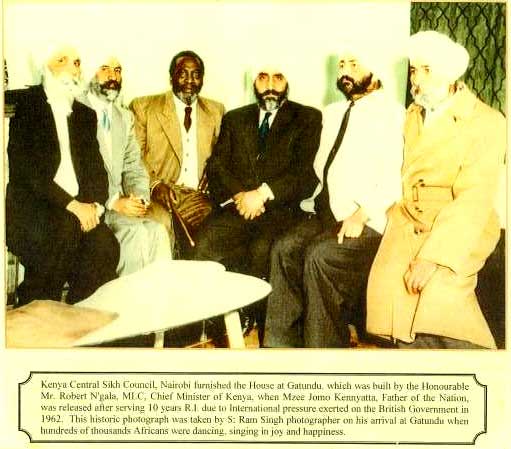
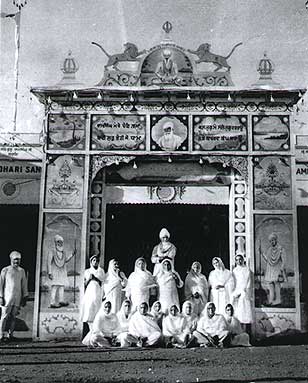
This gate was built and decorated with paintings by S. Hari Singh Bansal (seen here between the ladies). This gate was built in 1959 to welcome Satguru Partap Singh Ji to East Africa. Hari Singh Bansal was also responsible for the building of the above Sikh gate to welcome Princess Margaret.

A huge African tree somewhere near Arusha with a Sikh pioneer.

A fall near Moshi (Tanzania) - one of the spectacular scenes in Africa. There is a saying that if 'you have not seen Africa - you have not seen anything!'

Nearly two tons of dead rhino lie in the foreground of this picture as mute evidence of the car's encounter on the Nairobi-Mombasa road.

Another scene on the Nairobi-Mombasa road

An international sign post at the old Nairobi Airport
The following story has been sent by Dr. Gurjinder Singh Bhari (living in U.K) about his great grand-dad Bhaia Ji Narain Singh who emigrated to Kenya in 1898 AD. We thank him for the information.
Narain Singh Bhari (well
known as Mistri ji)
Born approximately in the year 1863 in India, Pind Verka
District
Amritsar
He initially lived and worked in Lahore at his Massr's furniture shop. While working at the shop he was taught carpentry and joinery. He later signed up to go to East Africa to build the Uganda Railway.
He came to Mombasa, Kenya in 1898 on a two-year contract with the British Government and commenced work as a carpenter at the Makupa Railway Bridge. Makupa was also the site of the first Sikh Gurudwara in East Africa.
His colleagues were his elder brother Mr.Prem Singh and three others.
After
finishing his contract while working with railways on the main line which was
running from Mombasa to Kisumu, he boarded the train back at Fort Ternan, which
is halfway between Nauru and Kisumu. He was offered an extension of his contract,
but seeing his colleagues depart at the railway station, he joined them and returned
to India. While working on the main line they had a tough life because fear of
wild life, sickness, jiggers in their feet and had to live in tents.
He then
travelled between India and Kenya a few times before he returned to settle permanently
in Kenya.
On his return, Bhaia ji (as the family lovingly calls
him) started working in Limuru for British East Africa Saw Mill (popularly known
as BEA Saw Mills) and worked for three years. While working at B.E.A. Saw Mills
he was taught
saw milling by Mr. McClure (a Scot) and became a saw doctor.
In 1906 he started working in Nairobi for Equator Saw Mill, which had their branches
in Maji Muzuri and Sabatia. Colonel E.S. Grogan ( Grogan Road, below River
Road, in Nairobi was named after him) was the owner of these Saw Mills. Mr.
Narain Singh worked for the mill for approximately 23 years. The newspaper cutting
from the Sunday Post Newspaper indicates the high regard held by Colonel Grogan
for Bhaia ji.
After working with Equator Saw Mill he worked with various small-building contractors. Eventually in 1929 he opened his own construction company.
By this time he was already a grandfather to Manmohan Kaur who would be affectionately known as` Mohni Panji' among the ladies because of her satsang every week in Pangani for Babe Nanki and was very close to Bibiji ( Bibi Balwant Kaur) who is the head of Bebe Nanki movement. His son Piara Singh was an ardent sportsman and won many trophies for motorbike races. His elder son Gurbux Singh later joined him in his construction company.
The cutting from E.A. Standard newspaper dated 2nd. November 2000 shows the corner of the building now Commonwealth House on Moi Avenue (formerly Government Road near Harding Street), which had offices (around 1950) of Narain Singh Gurbux Singh Ltd. (Below)
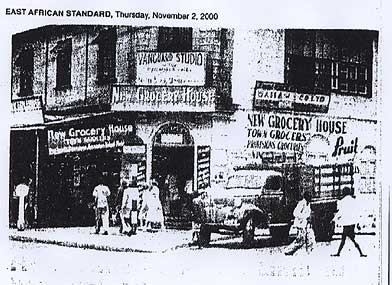
There
was a furniture shop at the ground floor belonging to Mr. Bassan (see below
in OLD MEMORIES)-who later initiated renovations to Sikh Gurdwara in Makindu.
Enclosed is also a photograph showing Chevrolet model 1940 belonging to the family all equipped for a "Safari" journey either to Mombasa or Kisumu. In 1950 most of the roads were dirt roads and it was very easy for somebody to get bogged in mud. (Below)
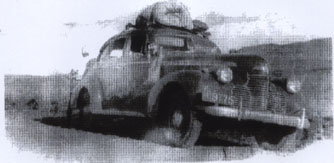
Bhaia
ji was involved in the building of projects in Kariokor, and Kaloleni African
Housing Estates (for Nairobi City Council), and extensions to the National Museum
and Nairobi Club. In 1932 he constructed the General
Hospital in Nyeri, Kenya.
Two
beautiful houses apart from others were built in Nairobi one for Mr.Erskine on
Riverside Drive and the other was for the Official Residence of the South African
High Commissioner on Nairobi Hill (now Kibera). Well
known architects M/S.
Blackburn Norman designed the Commissioner's house.
Bhaia ji
had a quarry near the present Mater Hospital in South 'B'. He used to supply ballast
to the Nairobi City Council and also to the Uganda Railways at Voi and Taru. At
the quarry he had a workshop where he made his
own furniture and joinery for
the construction projects he was carrying out at that time. At the quarry he also
had a small 'shamba' and planted yellow maize and kept a few dairy cows.
Mr.
Narain Singh was very respectable person among the Sikh Community in Nairobi.
He was Chairman and a trustee of Siri Guru Singh Sabha Nairobi for many years.
He used to arbitrate in feuds between families and friends
In the earlier
days he used to live in his own house near what is now Landhies Road. The house
was well known and became famous by the name of 'Ardu Walla Verrah' because it
had some peach trees in the courtyard. Even now people still remember the house
by that name and older generations may refer to the family as the 'Ardu Walley'.
Mistri Narain Singh was a very generous person and always helped people in difficulties.
He used to let
people stay in the house free of charge for a few days when
they used to come from India to Kenya.
In 1948 he moved to
the house constructed by him and his sons in Parklands.
One of his sons, Gurbux
Singh Bhari is the patriarch of our family. He is 93 years old and lives in the
same family home in Parklands.
Bhaia ji had seen some of his great grand children before he passed away in 1963 at the age of nearly 100years and left the family with pleasant memories and rich teachings. His great- and great-great- grandchildren live in Kenya, the US, Canada, the UK and India.
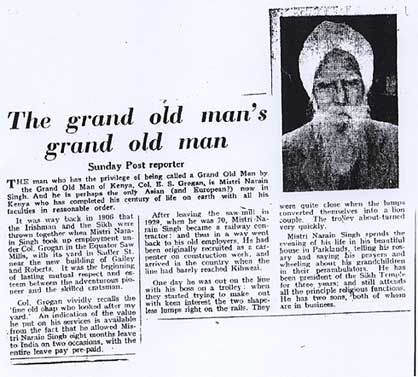
OLD MEMORIES
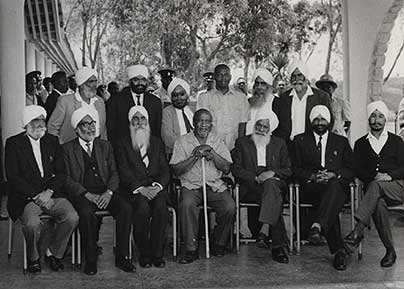
Prominent Sikh leaders with President Mzee Jomo Kenyatta of Kenya.On left of the President is S.Sardar Singh Vohra and on his right is S.Balwant Singh Panesar. Behind the President is S. Sampuran Singh Bassan (black specs) on whose right is S. Didar Singh. And on his left near the African guard is S.Mangal Singh Bansal (watchmaker) and S. Gian Singh Jandu. Left of S.Sardar Singh Vohra, S.Narinder Singh & S. Gurdev Singh Sagoo. (Some names are forgotten or not known - kanwal)
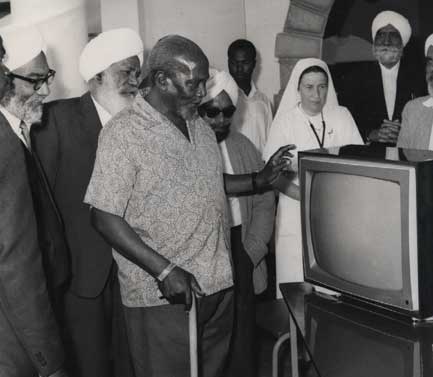
The members of the Sikh Community present Gutundu Hospital with a TV set. S. Sardar Singh Vohra and S. Sampuran Singh Bassan can be seen on each side of the President.
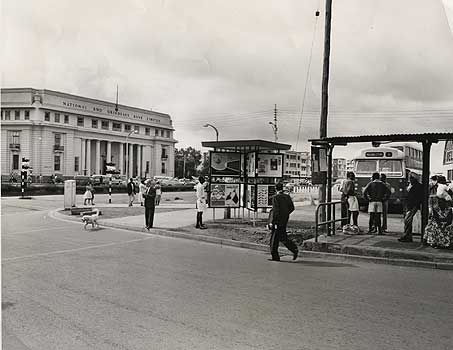
A scene of National & Grindlays Bank opposite the Bus Station in Government Road during the 50's
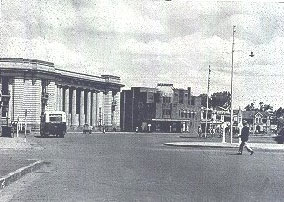
Another view of the above with the Capitol Cinema next to it.
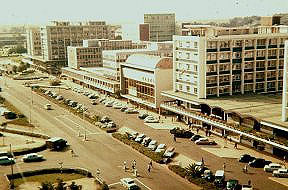
A scene of Government Road with the Kenya Cinema on the right 60's
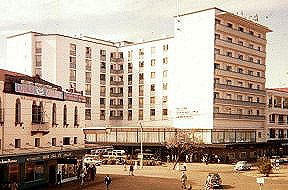
The New Stanley Hotel on Delamere Avenue. The building on the left was occupied by David Lyall Ltd. -The Omega people.
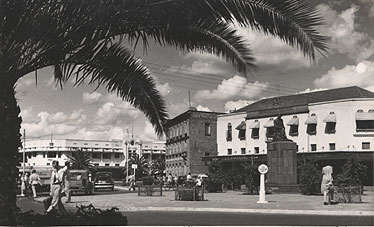
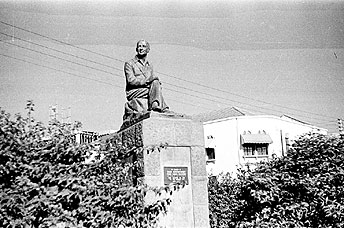
Delamere Avenue with the statue of Lord Delamere opposite David Lyall Ltd, the Omega people. The building on its left was demolished for the new Barclays Bank Government Road branch. This photo was taken before UHURU.
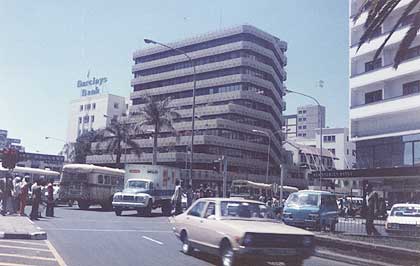
This photo taken in 1985 shows the Barclays bank building and a new building next to it. A complete contrast from the top picture.
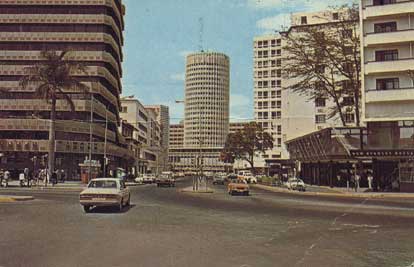
Another view of the above pictures with the New Stanley Hotel on the right.
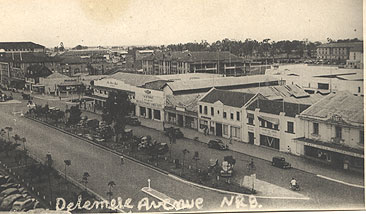
Delamere Avenue during the 50's
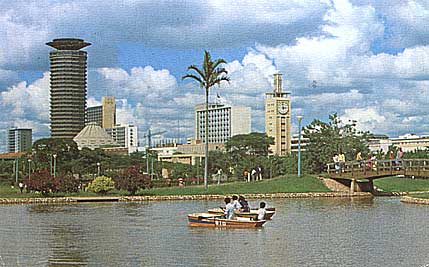
The picturesque Nairobi with the Parliament House, Kenyatta Conference Centre in the background against the Uhuru Park.
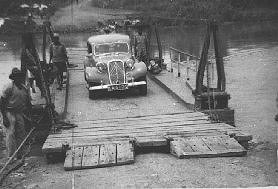
A citroen car crossing a ferry at Kagera in Uganda
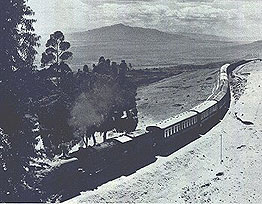
A train winding through the great Rift Valley of Kenya

An Italian built church in the escarpment (rift valley) between Nairobi and Nakuru
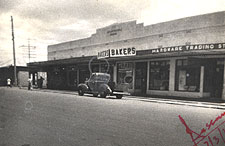
A photograph taken in 1949 of the main street Nakuru
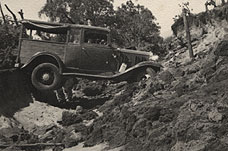
The car! - the road! tell the full story
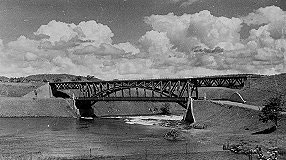
The Jinja Bridge on the Nile
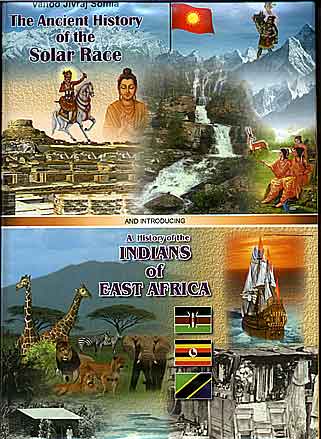
Title of a book written by Vanoo Jivraj Somia about Indians of East Africa
Arrival
of Kenya's Sikhs
By Zarina Patel
Sikhs in East Africa are popularly
known as 'Kalasingha'. I had always assumed that the word was a Kiswahili derivative
until I discovered that 'Sardar Kala Singh' was the name of an individual who
came to East Africa in 1896. He traveled all over the country meeting the local
people and became a familiar figure. As he wore the distinctive male Sikh attire
his 'tribe' became easily distinguished and well known. So much so that to this
day when graphic artists want to depict a South Asian character, they draw a Sikh
with his turban.
Most of the Sikhs in Kenya are descendants
of the artisans and labourers who came to build the Uganda Railway for the British
colonialists. These hardy workers were physically strong and highly skilled and
most belonged to the Ramgharia sect. In 1908 when Churchill praised the Sikh soldier
in his book, African Journey, he was referring to the smaller section of Sikh
Jats. Both groups came from what was then the Punjab in northwestern India.
Best
known and most famous of them all is Makhan Singh, the founder of organized trade
unionism in Kenya. But even before Makhan Singh set foot in East Africa, Sikh
workers were already leading the struggle for workers' rights. His father Sudh
Singh was the main organizer of a group of railway workers, all Sikhs, who agitated
for better working conditions. Some of his colleagues were Gurbux Singh, Ojagar
Singh, Kishen Singh, Bhagwan Singh and Kaiser Singh. In 1921 Sudh Singh was dismissed
from the railway for his activities.
After trying his hand at various trades,
Sudh Singh set up a printing press. Other Sikhs became traders, contractors, builders,
furniture makers, saw millers, motor mechanics, electricians, tailors and blacksmiths.
Renowned as expert 'fundis', a stereotype developed of the Sikhs as a people of
physical prowess but lacking intellectual know-how. Hence the many jokes about
their escapades.
The stereotype is just a label and belies the reality. Makhan
Singh was one of Kenya's most committed intellectuals who, in 1950, made the first
call for uhuru. Previous to that, in the 1930s, Gujjar Singh had been president
of the Workers' Society of Kenya and Hem Singh, president of the IndianContractors
and Builders Association. In Dar-es-salaam, the secretary of the Asiatic Labour
Union was Gurcharan Singh. By 1933, Naher Singh Mangat was a practising lawyer
and a member of the Legislative Council. His son, J. S. Mangat, was the first
South Asian to write a detailed and substantive history of the South Asian community
in Kenya.
Chanan Singh was another outstanding Sikh. A brilliant lawyer and
a great Kenyan patriot; he defended Kenya's freedom fighters. Amongst his many
accomplishments, he was once parliamentary secretary to Prime Minister Jomo Kenyatta.
Jaswant Singh Bharaj made guns for the Mau Mau. Narain Singh was editor of the
Sunday Post and claimed that 'Asians originated nationalism in Kenya'. Jasmer
Singh, at one time editor of Drum magazine, is a sports personality in the cricket
world and Joginder Singh is a rally driver.
Sikh philanthropic institutions
are much admired. The Sikhs have a worldwide tradition of building rest-houses
and providing food. The service is open to all travelers and the temple at Makindu
on the Mombasa-Nairobi highway, is the best example of this. The Khalsa schools
and hospitals cater to the ordinary wananchi as well as their own community members.
Sikh professionals and businessmen are active in service organizations such as
the Lions and Rotarv.Class differences have generated much debate within the Ramgharia
community and between the Ramgharias and the Siri Guru Singh Saba, an organization
of the Jat Sikhs. With modernization the dividing lines have become fainter but
it is this presence of a large working class that has endeared the Sikhs to the
African masses. Devoid of the caste prejudices which so often handicap the South
Asian psyche, they are able to socialize and mingle with their fellow African
workers. Their hardy physique and outgoing demeanour, their willingness to share
a drink or two and their camaraderie enables them to cross cultural and racial
barriers. Familiesraised by Sikh men married to African women are scattered throughout
Kenya.
Sikh women have made great strides in education but they, like their
South Asian sisters, are still bound by their cultural traditions. They are largely
active within the women's wings of their gurdwara and communal milieu, conducting
prayers and collecting funds for charity.
Almost two-thirds of the Sikh community
in Kenya emigrated after independence. Nevertheless those that remain form a dynamic
and vibrant group of Kenyans who continue to make their mark, and are much respected,
on the national scene.
(The above article taken with courtesy from a brochure
by Gurdwara Ram. railways centenary celebrations)
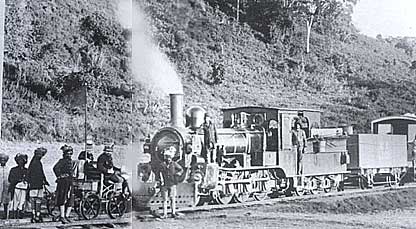
Sikhs and other asian staff by the Uganda Railway engine - around 1930's
SOME MORE MEMORIES - IN PICTURES
THE POETS
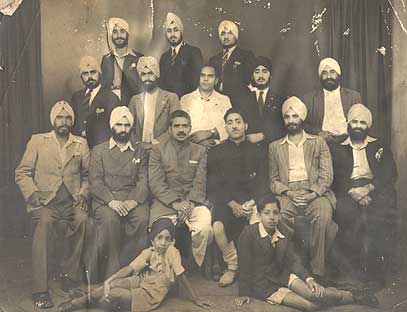
Poets of 'JAI HIND KAVI MANDAL' Nairobi. Photo taken in 1946. Third from left seated is Pandit Laxmi Narain Shastri 'Gardish' - a prominent figure in Nairobi. Harjinder kanwal's father P.S. Kanwal is on the extreme right seated.

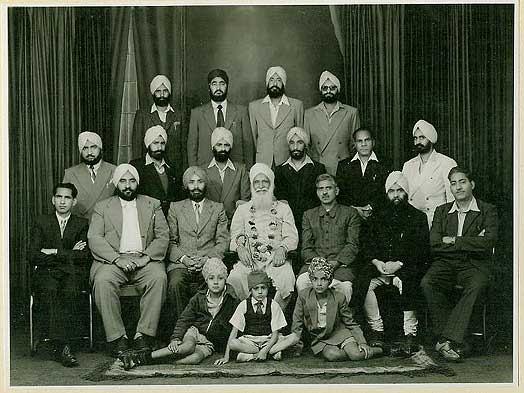

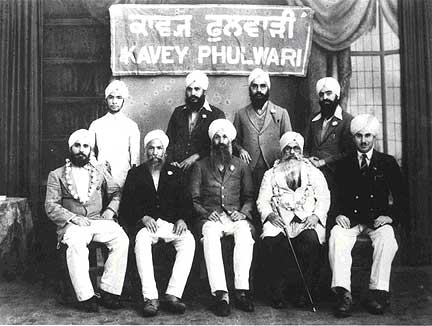
Photo taken in 1930 - Members of Kavya Phulwari
From LtoR sitting: Gopal Singh Chandan, Prem Singh Mastana Jogi, Ragi labh Singh, Giani Gian Singh Mahilpuri & Sita Ram Mangal: Standing LtoR Makhan Singh, Bishan Singh Bara Pind, Devinder Singh Dev & Meharban Singh
.jpg)
VOK broadcaster poet Chaman lal Chaman reciting his poetry at a symposium. Sitting are S.Gopal Singh Chandan and Prem Singh. (photo courtesy A.Chandan )
MACHAKOS
A small town 43 miles from Nairobi towards Mombasa. The railway line passes near Konza, a station near Machakos. This town is surrounded by hills on all four sides and is very picturesque. Some of the people who lived there have sent some photographs and brief descriptions of their lives spent in this lovely town. Here are some of the historical pictures and brief accounts.
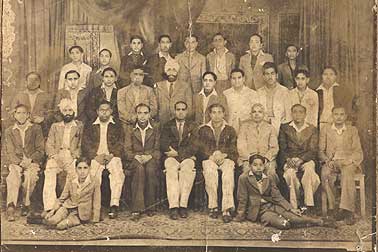
1942 - Machakos, Kenya - only a handful of Sikhs were there at the time. Kanwal's father P.S.Kanwal second from left sitting and Mr. Mastan Singh Mangat, standing in middle.This photo is of members of the Machakos volleyball team and nearly all the Indians residing in Machakos at the time.
THOSE WERE THE DAYS
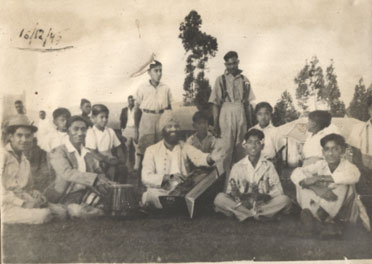
P.S.Kanwal with his group of musicians enjoying in Kitui, near Machakos in 1945.

Young Harjinder kanwal -fourth from left with his father P.S.Kanwal who played part of Raja Harish Chandra in a play -'Satyavadi Raja Harish Chandra' staged at Machakos on January 5th 1946. Members of 'Machakos Youth League Dramatic Society' can be seen in various drama uniforms. This play was probably one of the FIRST stage dramas enacted in Kenya.
Mr. Phuman Singh Kanwal opened his own shop in Machakos in 1936 which dealt in Cycle Repairs, watch Repairs, Gramophone repairs & photography e.g. practically all sorts of jobs were undertaken. He closed this business in 1948 and moved to Nairobi.
Another relatives of Mr. kanwal were M/s Dalip Singh & Sewa Singh who also had their business in Machakos which dealt in Cycle repairs and Saw Mills. This business thrived extremely well and was later on managed by Mr. Dalip Singh's sons Mohan Singh & Gurbux Singh who named their firm Dalip Singh & Sons Ltd. A photograph of the family of S. Dalip Singh with their grandfather S. Amar Singh & father S. Dalip Singh tis seen with the rest of the staff:-
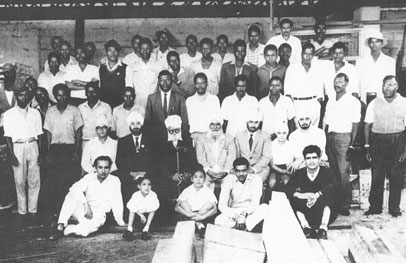
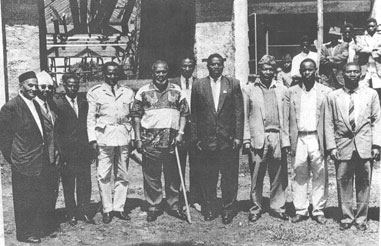
A delegate of businessmen from Machakos went to see the President of Kenya Mzee Jomo Kenyata in 1965. Mr. Mohan Singh (second from left) seen here with the delegates.
A letter from Usha Kiran Chhabra is printed here with information about her grandfather who lived in Machakos:-
My Nanaji, Mr Harbans Singh Bhamra lived in Machakos between the years of 1943 to 1972 with his wife, my Nani-ma, Mrs. Mohinder Kaur Bhamra, and their 7 children, Jaswinder(gudi), Rajinder (pupi), Ajit, Ashok, Jaspal, Harpal (Muna) and Kamaljeet (Baby). They spent many idyllic days there and he fondly recalled his times there.
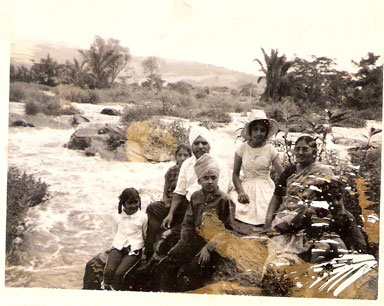 Bhamra family on a picnic near one of the many rivers in the district of Machakos.
Bhamra family on a picnic near one of the many rivers in the district of Machakos.
My Nanaji had a TV shop there that was pretty well known there. One early memory of one of my Masi's was that of the early evenings, when many of the town's people would come into the store and sit on the floor to watch programmes like Bonanza and Pop-Eye..
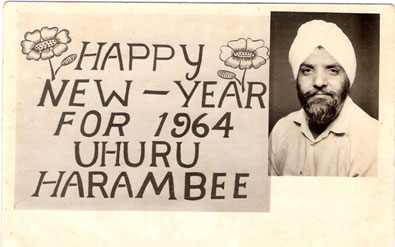 Mr. Harbans Singh Bhamra
Mr. Harbans Singh Bhamra
The family loved the life there and made many friends there, who they kept in contact with through the generations. A married friend of mine visited me in the States when I was with my Grandparents ( they moved to the Uk in 1972 and then the States in 1988) and her Husband happened to be My Nanaji's friend's Grandson from Machakos- Small world! But you hear of these stories so much.
My Grandparents leave 7 Children, 15 Grand-children and 6 Great Grand-children and they are so so missed!!! They were such a happy, sociable and sucessful couple....
Any more information, please email me. I am sorry if I have waffled on.
Kindest of regards
Usha-Kiran Chabra (USA)
Talking about Dramatic societies and art in Kenya, who can forget the name of Harbhajan Preet, who being a teacher in City Primary School, was an excellent actor who later on became a good director.
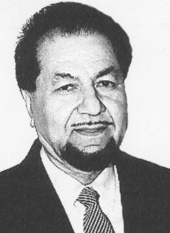
HARBHAJAN PREET
Harbhajan Preet was born in Punjab and went to live in Kenya in 1947 where he trained as a teacher and was groomed in the art of acting and stagecraft by his multi-talented tutor and theatre personality of Kenya, Joseph Clement.
He appeared in a series of Joe Clement's highly acclaimed productions at the Kenya National Theatre, Nairobi, including the Kenya Drama Festival award winning successes Andre Obey's, "Noah and The Singing Maid" for which he was adjudged the best actor in 1955. Following this he appeared in Mombasa Shakespeare Group's, "The Merchant of Venice", as Shylock, Hassan and Carrington V.C. at Little Theatre Club, Mombasa and Theatre Taliesin's, "Trystan and Essyllt" in Cardiff where he has lived since 1978.
The plays he has directed over the years include, The Singing Maid, Dhong, Uljhan, The Price of Perfection, Loona and Mohammed Hassan of Griftn, a multi-lingual National Schools Drama Festival Award Winning play which he also wrote in Kenya, Dhong in Cardiff and Chaman Lal Chaman's bilingual success "Palam to Heathrow" at Paul Robeson Theatre in London.
Quoting his mentor, Joe Clement, he maintains that the Theatre to him is, "not just fun - it's work, work, work."
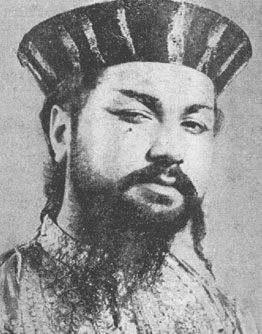 Harbhajan Preet as 'Wang Yan' in the play "Lady Precious Stream" directed by Joseph Clement - 5-9th May 1953 at Kenya National Theatre-Nairobi.
Harbhajan Preet as 'Wang Yan' in the play "Lady Precious Stream" directed by Joseph Clement - 5-9th May 1953 at Kenya National Theatre-Nairobi.
Preet as Hassan in the play 'Kismet' at the Kenya National Theatre 24/29 th May 1954 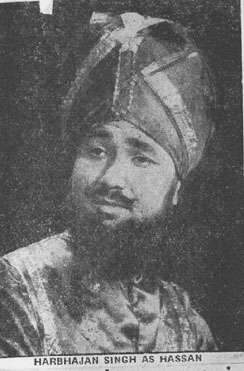
Harbhajan Preet was one of the finest actors in Kenya. He acted and directed a number of plays and won many prestigious awards and acclaims. He directed Rashpal Panesar in a number of plays.
The following article was printed in the East African Standard on January 16, 1986 on the sad demise of another very talented actor - Rashpal Panesar (below) - a student and then a teacher of Eastleigh Secondary School - see section Miscellaneous -ESS).
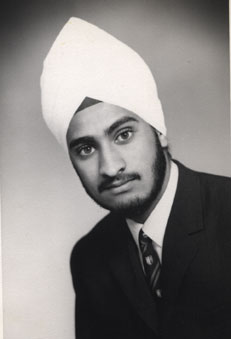
This article was written by Nigel Slade
PANESAR LEAVES FOND MEMORIES
"I knew him: a fellow of infinite jest, of most excellent fancy." (Hamlet)
In
these still dawning days of 1986 a shadow has fallen with the quiet passing of
Rashpal Panesar, one of the most gifted comedians to brighten Nairobi's
stages. He was only 37 years old.
Death can affect us of the theatre in two
different ways. On the one hand it provides the material for much of the drama
on and through which we work. The true actor uses it as a means to evoke emotion
without himself being affected, no matter how much he may seem so.On the other
hand, when it is real and concerns a fellow-thespian, it touches us in special
ways over and above those normally occasioned. One of these is the profound sadness
that never again shall we enjoy the deceased's own proficiency in the art we all
love so dearly.
"Where be your gibes now? Your gambols?" asks
Hamlet of the long-departed jester Yorick. It is now that sorrowfully we ask these
questions of Rashpal.
I do not think that Rashpal was ever formally trained.
What he came to know of stagecraft was purely from practical experience, the business
of "getting up and trying it". It was thus that he developed his own
brand of comedy which put him in demand by many groups and which had just begun
to win him a reputation amongst audiences.
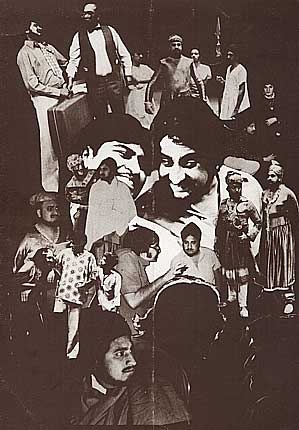
Apologetic
I
adored his style. He was never a deliberate comic. Rather he won laughter for
the faint but noticeable "bewilderment" which characterised his playing.
It was as if he was never fully au fait with what was happening (though
in reality he was, very much so!) and he gained many more laughs For often appearing
mildly apologetic for his puzzlement.
I recall once discussing his style with
a connoisseur of cinema.
He reminds me of a cross between Buster Keaton
and Danny Kaye," said he. True - but Rashpal had more than just Keaton or
Kaye about him. He had Rashpal!
Anothar effect of an actor'a death on
theatre- folks is toremind them that, though they do not know each other and have
different ideas about theatre, they belong to a great, if unseen fraternity.
Fitting
So
will it be with Rashpal Indeed even more so- Rashpal was one of those very few
able to cross the cultural barriers which so demarcate our different forms of
theatre. Indian theatre, Kenyan theatre, Western theatre - he raised laughs for
and with them all. He belonged to them all.
It is fitting then that
aspecial evening in appreciation of his memory will be held at the National Theatre
next Sunday at 6p.m. Here is a wonderful chance for all of us, with our very different
ways, to get together and salute a man who had only oneway. and that was for all.
Off-stage
Rashpal was a mild but sociable man, who never boasted of his talent.
Like
any artist he welcomed praise for his work but he was often puzzled by it. He
once observed to me: "I just love the stage - any stage!
If people love
what 1 do, why, I can only love them in return." That was typical of
the
simple modesty of one who sought to be friends with everyone.
When I go to
the National Theatre on Sunday, I shall be full of memories of moments when he
had me laughing uncontrollably. My mind will be sad but my heart will be laughing.
That, I am sure, is how Rashpal would wish it.
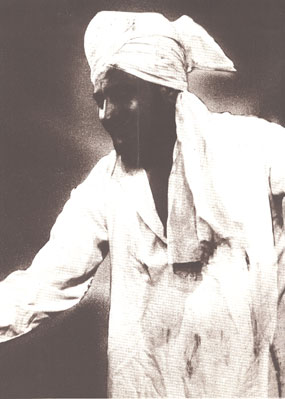
At the time of his departure Rashpal was the Chairperson of "Natak". Some of his major roles were in:
1. Ramesh Mehta's "Undersecretary".2.
Ramesh Mehta's "Khuli Baat" 3. Ramesh Mehta's "Roti aur Bet"
4. "Saray-ke-Bahar" 5. Shiv Batalvi's "Loona" 6. Waris Shah's
"Heer Ranjha" 7. Allaudin Qureshi's "Chachi O Chachi" 8. A.
Qureshi's "Parchhayian" 9. "Anarkali" 10. Shahnawaz Zaidi's
"Woh Manzilen Woh Raastey" 11. Shanawaz/Allaudin's "Do Duni Paanch"
12. Shahnawaz's "Aankh Micholi" 13. Balwant Gargi's "Kanak di Balli"
14. Allaudin's "Aashiana" 15 Swinder Gulatis "Paisa paisa Paisa".
And many TV skits and shows.
 (contributed by Prem Modgil)
(contributed by Prem Modgil)
SOME MORE OLD MEMORIES
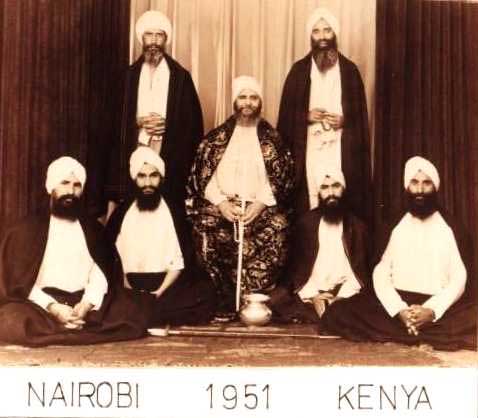
Sant Ishar Singh Ji Rarewale with Sangat members in Nairobi during his visit in 1951
............................................................................................................................

The following information has been sent by Suniti Mohindra with thanks
Meghjibhai P. Shah donated a life-size statue of Mahatma Gandhi for the Royal Technical College, ( Now Nairobi University) which was unveiled by the Vice-President (later President) of India, Dr. S. Radhakrishnan on 12th July 1956 at a ceremony in Nairobi when Suniti was at Duke of Gloucester School and raised funds to shower Dr. Radhakrsishnan with flower petals as his motorcade drove past the school going towards downtown Nairobi opposite the Lady Griggs Nursing Home on Nagara Road .(M.P.Shah who donated the MP SHAH HOSPITAL IN NAIROBI TO THE INDIAN COMMUNITY) This Hospital is still operative and serves all.
for more info please see link:-
http://www.herenow4u.de/Pages/eng/Sections/Meghji_Pethraj_Shah/MeghjiPethrajShah5.2Retir.htm
The M. P. Shah Hospital is Meghjibhai Pethraj Shah’s biggest monument in Kenya, but there were many other donations as well. The Igerton Agricultural Hospital benefited, and another gift provided accommodation for the disabled in Thika. Although at that time many people did not believe in girls' education, Meghjibhai's outlook on this issue was progressive and he believed firmly that it was not possible to improve society without educating girls. For this reason he gave every encouragement to this aim and persuaded the Kenyan government to expend large sums of money on girls' schools, hostels and primary schools. One large donation, which he made, was the sum of 200,000 sh. for the buildings of the Maniben M. P. Shah Girls' School at Kisumu.
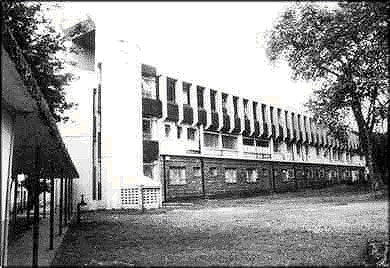
M.P.Shah Hospital - Nairobi
When it was decided, about 1952, to raise a fund for the establishment of the Gandhi Memorial Academy Society in East Africa, Meghjibhai undertook responsibility for the fund-raising. The original intention was to found a separate college but in the event the Society worked with the Royal Technical College. Meghjibhai and Hemrajbhai Nathoo Shah were trustees. The project had started with a good deal of dissension and lack of agreement on its objects. At a meeting on 28th August 1952 Meghjibhai argued vigorously for dissolving the large unwieldy committee and creating a small Provisional Committee. He carried the day and was elected Honorary Treasurer of the Fund. Meghjibhai donated a life-size statue of Mahatma Gandhi for the College, which was unveiled by the Vice-President (later President) of India, Dr. S. Radhakrishnan on 12th July 1956. (see below)
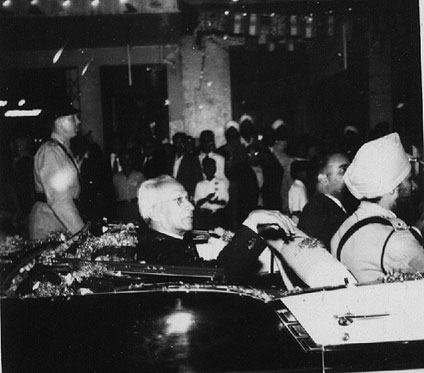
Dr. Radhakrishnan, the President of India came to Nairobi ,seen in an open car going through River Road with a Sikh Police Driver.
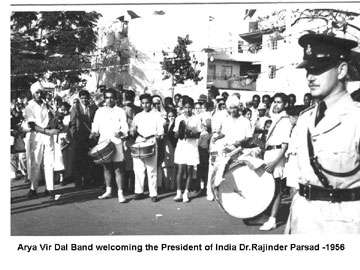
(photo contributed by Prem Modgil)
PUNJABI HERITAGE IN EAST AFRICA
The history of the South Asians in East Africa is not very old. It is only about 100 years since the first Indians landed on the shores of Kenya, namely Mombasa. The journeys in those days were accomplished in dhows which were the main source of transport and starting from Bombay the journeys could take as much as months to complete as the dhows depended on the state of the winds. It was after a lot of hardships that some of our ancestors reached Kenya to serve in the Uganda Railways which was being built from Mombasa to Kampala.
The Punjabis (Hindus, Muslims & Sikhs) were the main source of skilled and semi skilled labourers who worked on the railways. They suffered numerous hardships including the lions of Tsavo.
Do You or Your parents or Grandparents had any escapades, adventures, memorable incidents, interesting stories, their rise to fame or riches, old photographs or mementoes, souvenirs, brochures of Kenya, Uganda, Tanganyika - magazines printed by gurdwaras or federations, clubs, schools, students etc. Any documents or photos about East Africa – anything!
I am in the process of writing a book on the ‘Punjabi Heritage in East Africa’ and I need information as much as possible. Just get in touch with me and send me the information (which will be returned after use). Your name will be acknowledged in the book.
Your assistance would help in inserting your ancestors’ names in the history of East Africa.
Kindly contact,
Harjinder Singh Kanwal,
20 Trewint Close,
Exhall,
Coventry CV7 9FG
U.K.
Phone: 024 7631 9483
E/mail: harjinder@kanwal99.freeserve.co.uk